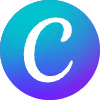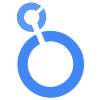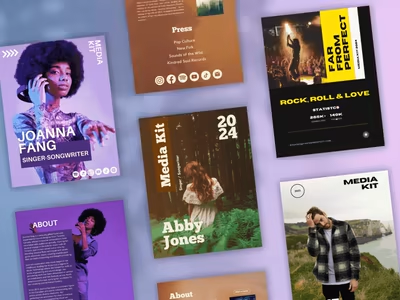Case Studies - US Tech
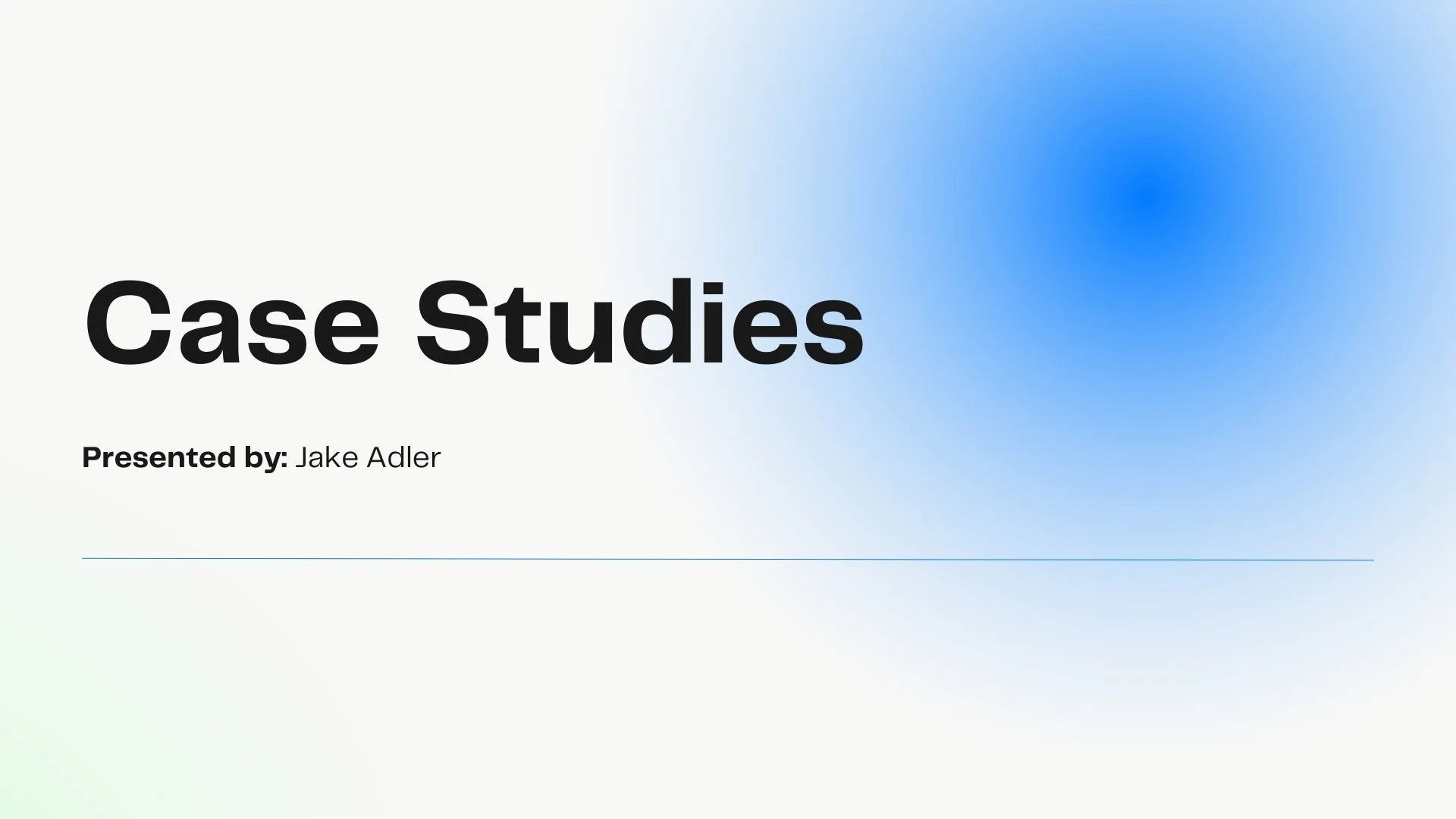
Over the last year, I've completed detailed marketing case studies for various SaaS companies in the US using advanced analytics, funnel optimization, and conversion tracking. Below you will find five of these studies with context and results.
Case Study 1 - Daybreak Health
Context
Daybreak Health is a digital mental health provider focused on increasing access to high-quality therapy services for youth. Historically, school districts played a primary role in funding Daybreak's services, but with grants being phased out, the company has shifted to an insurance-driven revenue model. This transition allows Daybreak to expand beyond school referrals and build partnerships with healthcare providers, insurance companies, and community-based organizations.
As the User Growth Lead, my task was to analyze referral data and identify opportunities to enhance patient acquisition and retention. This included:
Assessing conversion rates across referral sources.
Identifying top-performing geographic regions and referral types.
Recommending strategies to optimize the referral funnel and improve engagement with non-school-based referral sources.
Additionally, I developed a digital marketing strategy leveraging email marketing, social media, and in-person outreach to improve referral rates, with a limited paid advertising budget of $3,000 per month.
Data
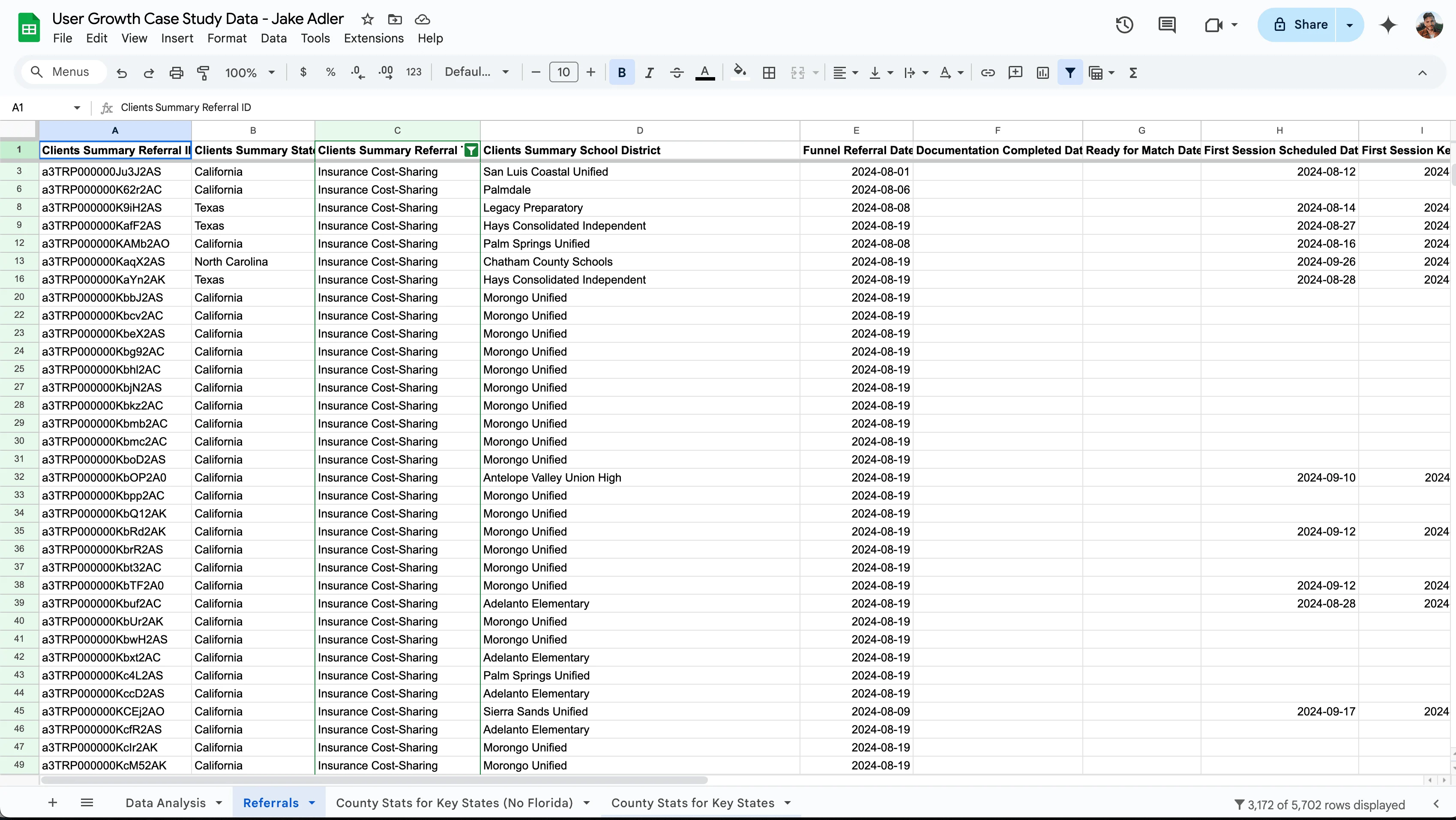
Daybreak Health Dataset Example
The dataset provided contained 6,177 referral records from the 2024-2025 school year, with details on referral sources, school districts, documentation completion rates, and appointment scheduling milestones.
Key insights from the data analysis:

My Funnel Analysis using COUNTIF Formulas and Equations
Referral Performance:
The Insurance Cost Sharing (ICS) model accounted for the highest volume of referrals (3,552), indicating that districts still contributing some funds play a crucial role in patient acquisition.
Kaiser referrals (771) showed strong engagement, benefiting from an existing partnership.
Freemium referrals (154) were low in volume but represent a key area for future growth as Daybreak moves towards an insurance-focused model.
Conversion Trends:
The highest completion-to-first-session rates came from ICS and Kaiser referrals, suggesting that existing partnerships with structured referral pathways drive better outcomes.
Freemium school referrals had slower conversions, highlighting potential friction in parent engagement and insurance verification.
Regional disparities showed that IL, CA, and NC had more favorable insurance coverage rates, making them prime markets for expansion.
Opportunities for Growth:
Expanding community-based referral networks (e.g., pediatricians, after-school programs, youth organizations) could increase referral diversity.
Improving parent outreach through targeted email marketing and digital content could enhance engagement in Freemium districts.
Enhancing the digital onboarding experience (simplified documentation process, proactive scheduling) could reduce drop-offs in the funnel.
These insights formed the basis for my strategic recommendations to optimize referral engagement, conversion rates, and long-term patient acquisition.
Deliverables: Memo 1 & 2
I was tasked with delivering two memos varying in length from 4-5 pages each. The first with my funnel analysis and findings, and the second with my digital strategy for 2025.
Presentation
I designed and presented my funnel analysis, and memo findings to a panel of C-Suite executives at the company.
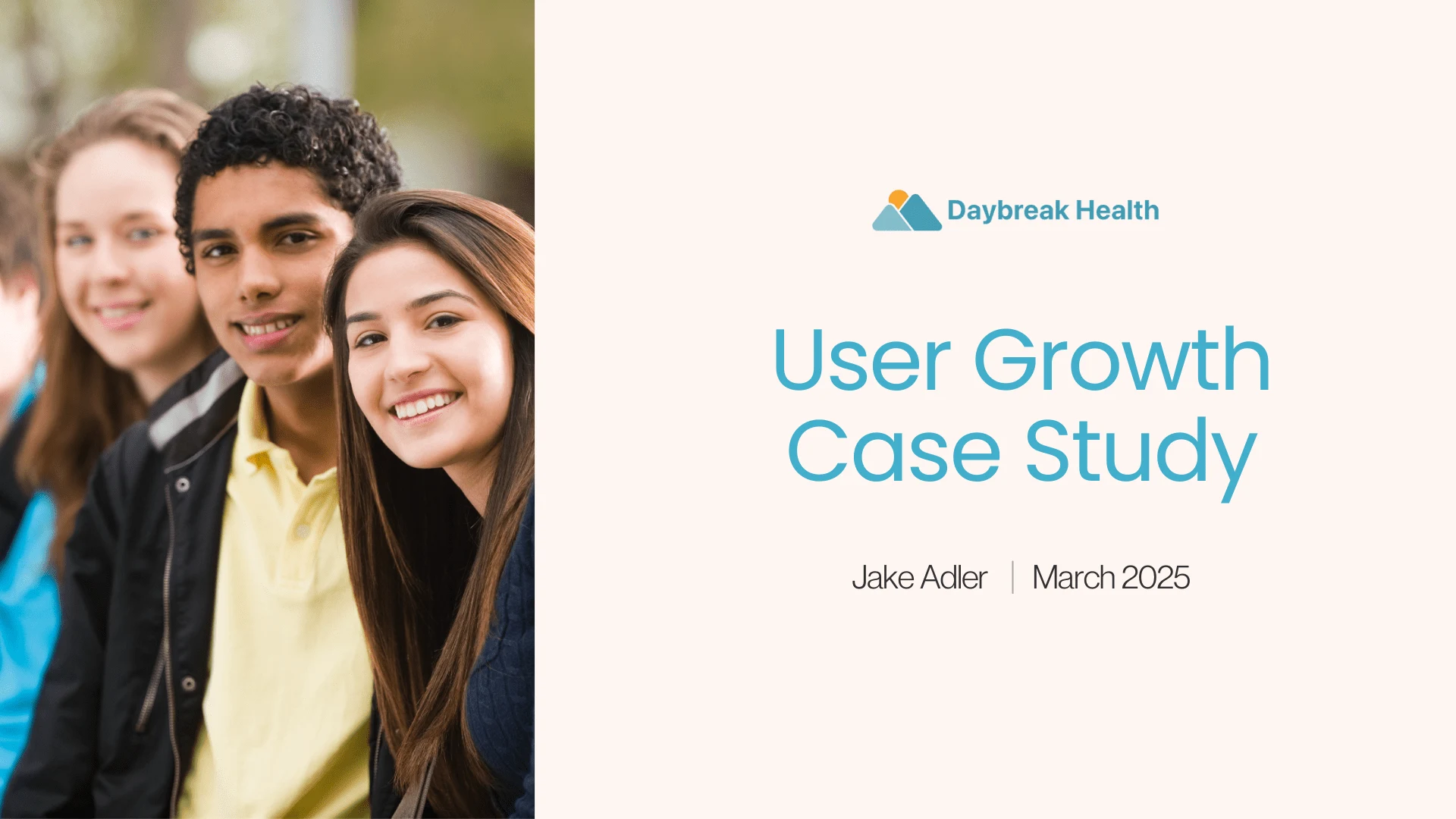
Slide 1
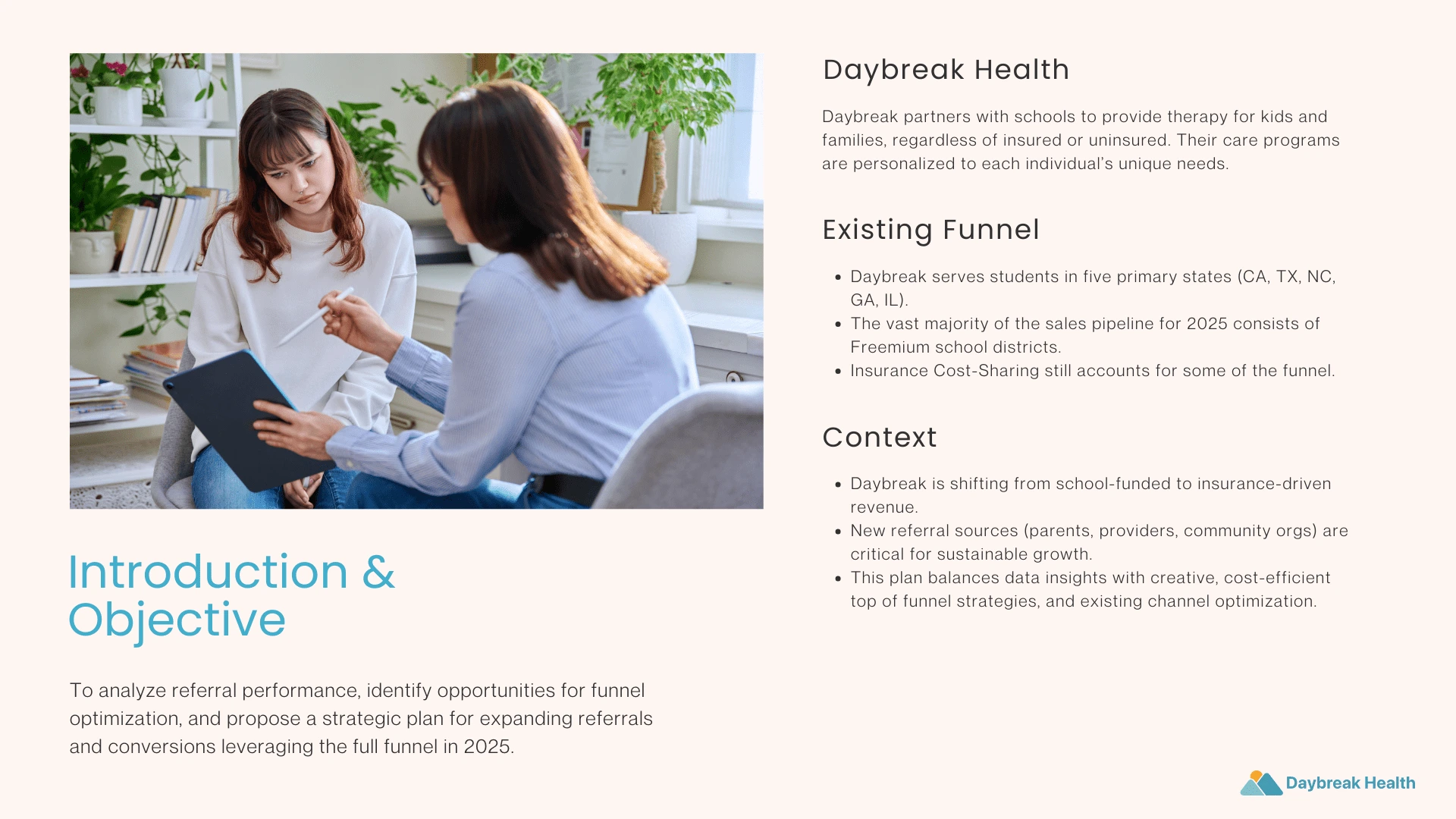
Slide 2
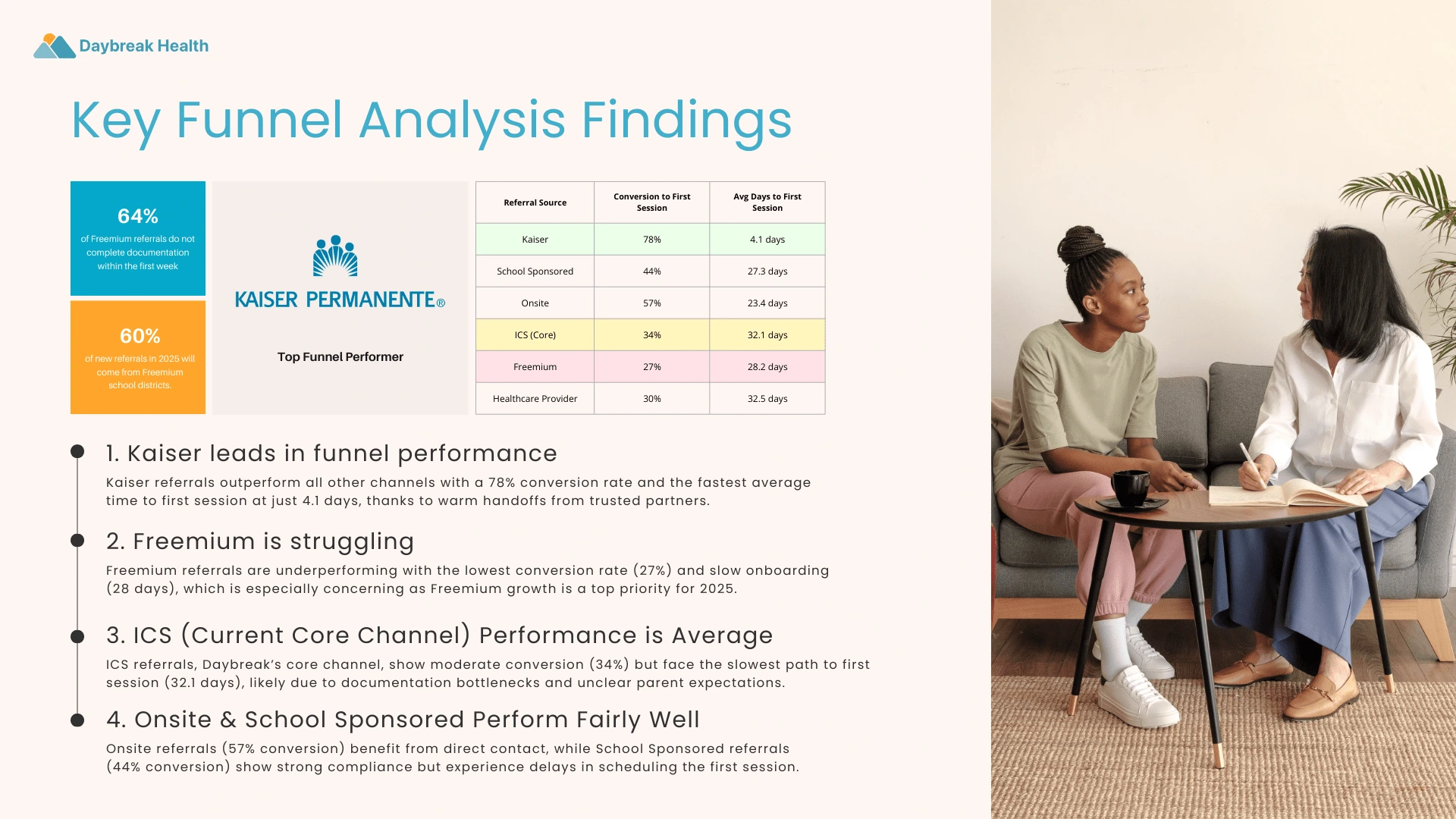
Slide 3
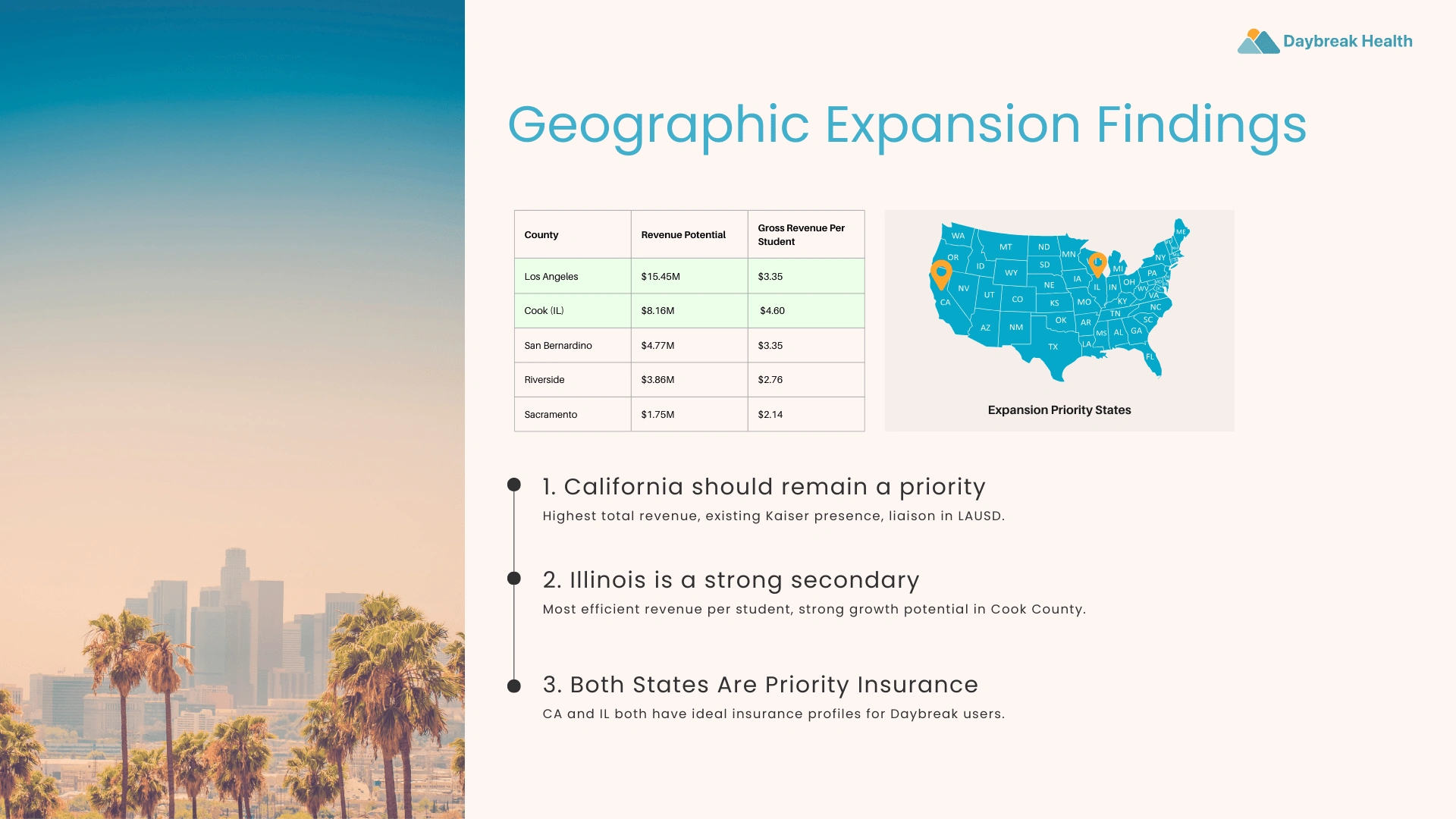
Slide 4
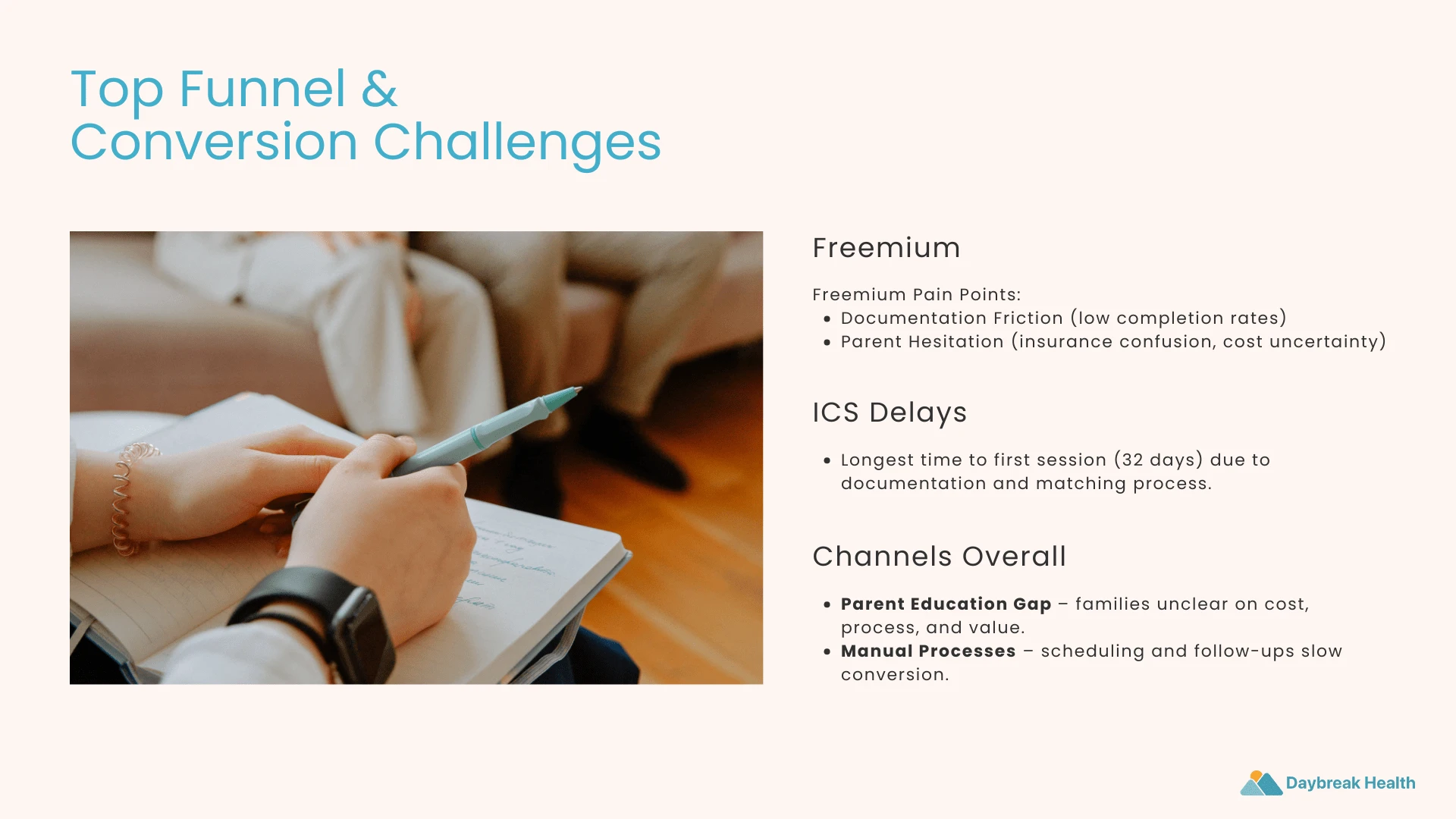
Slide 5
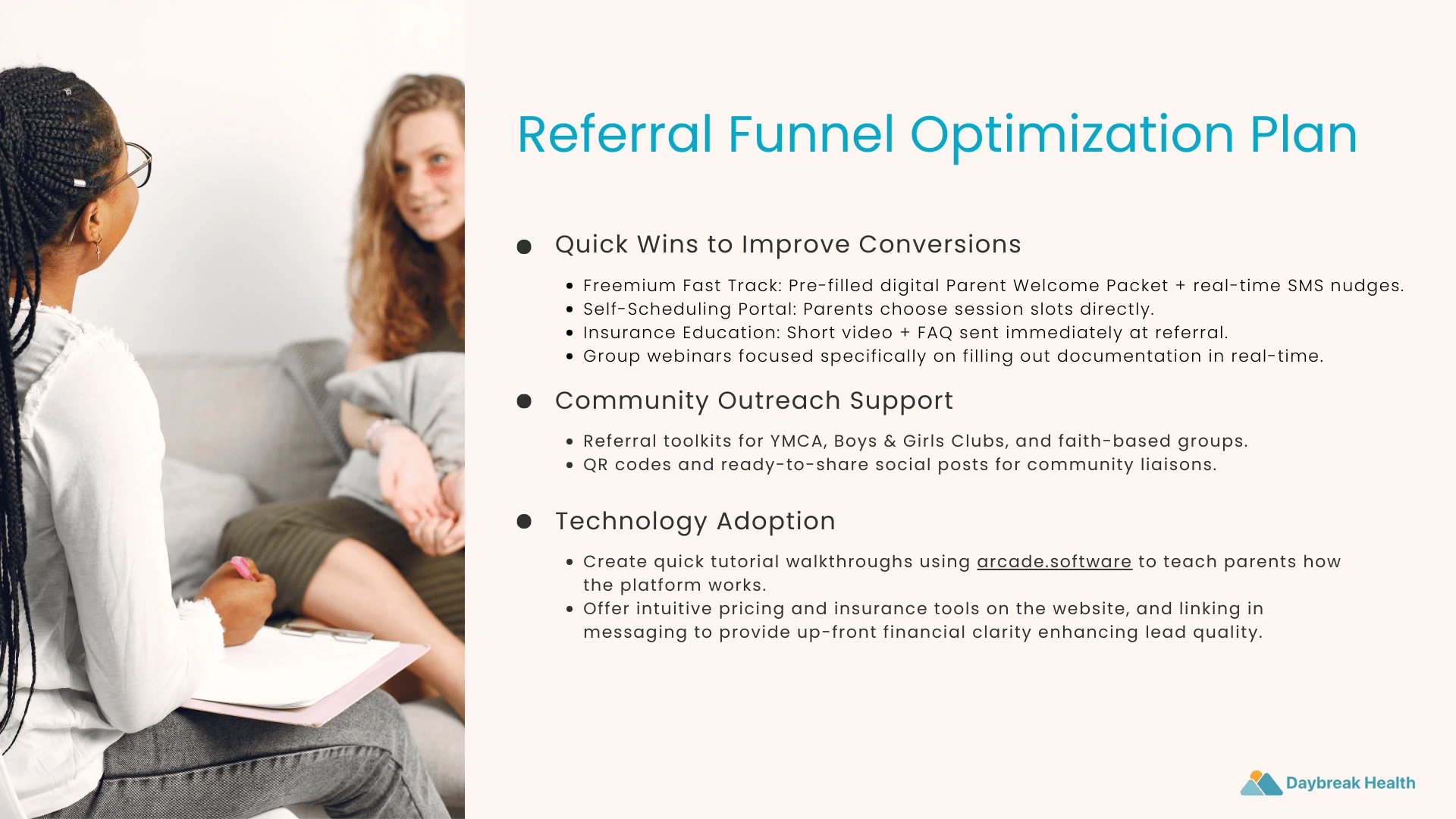
Slide 6
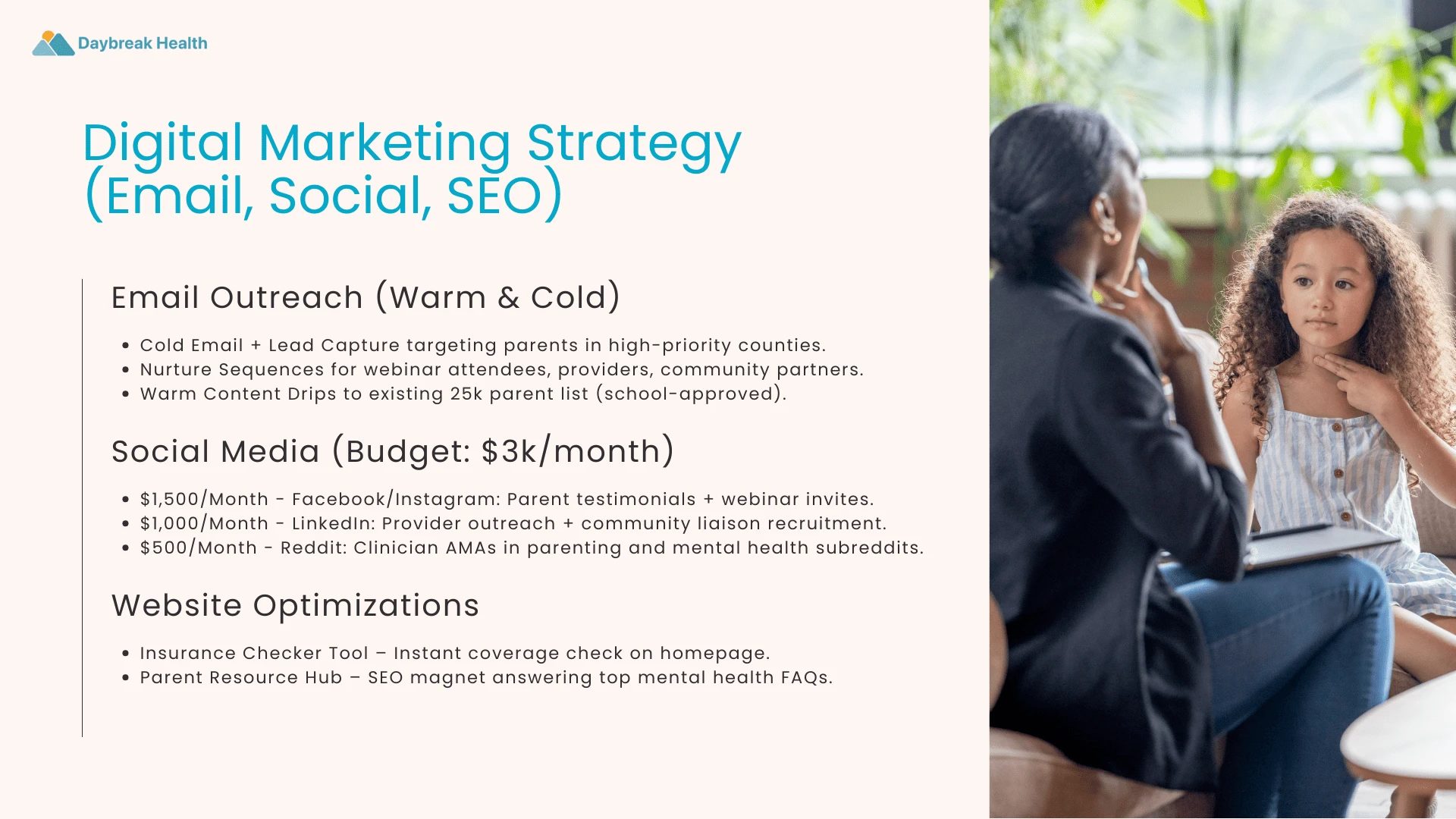
Slide 7
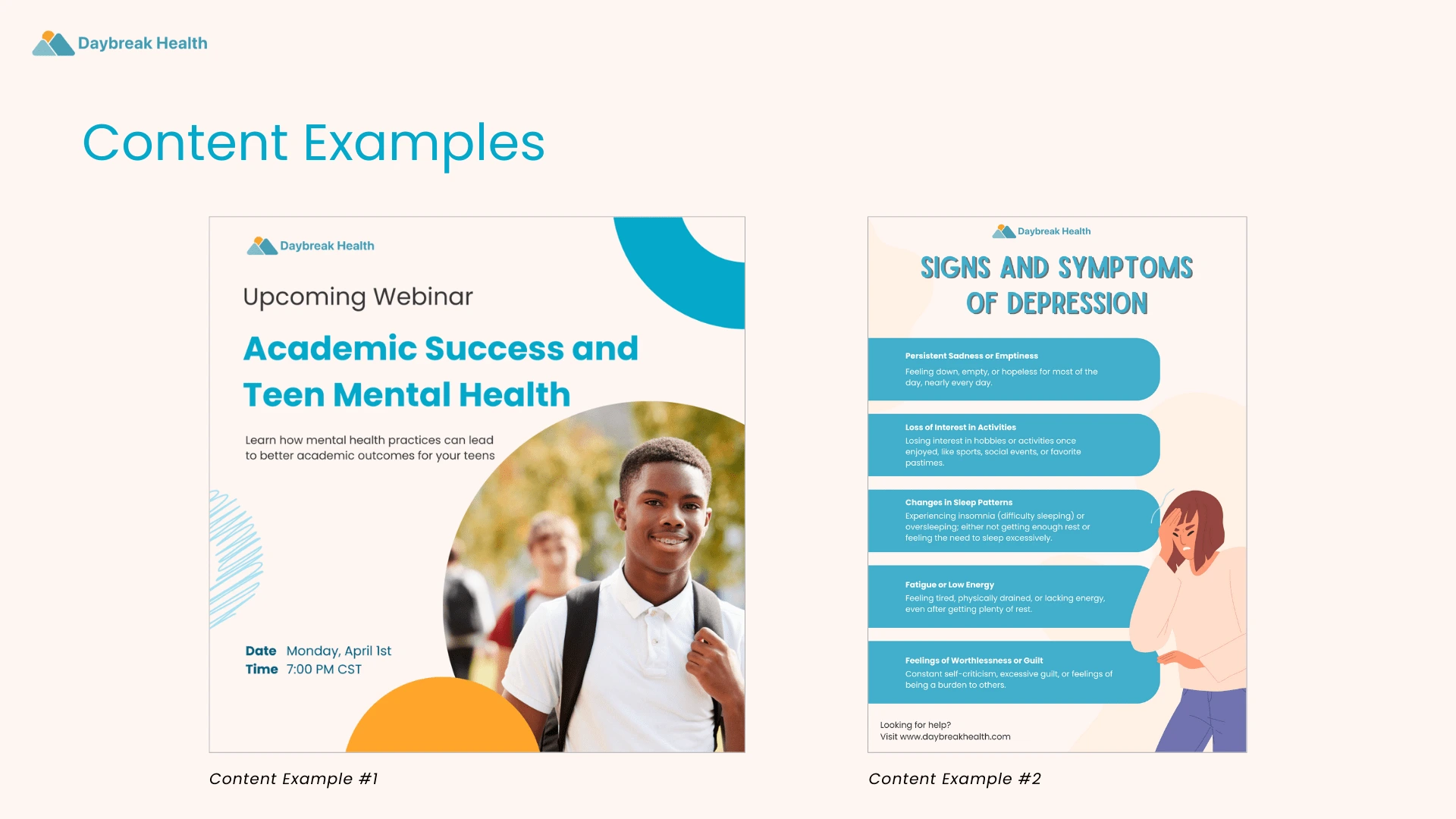
Slide 8 - Content Examples

Slide 9
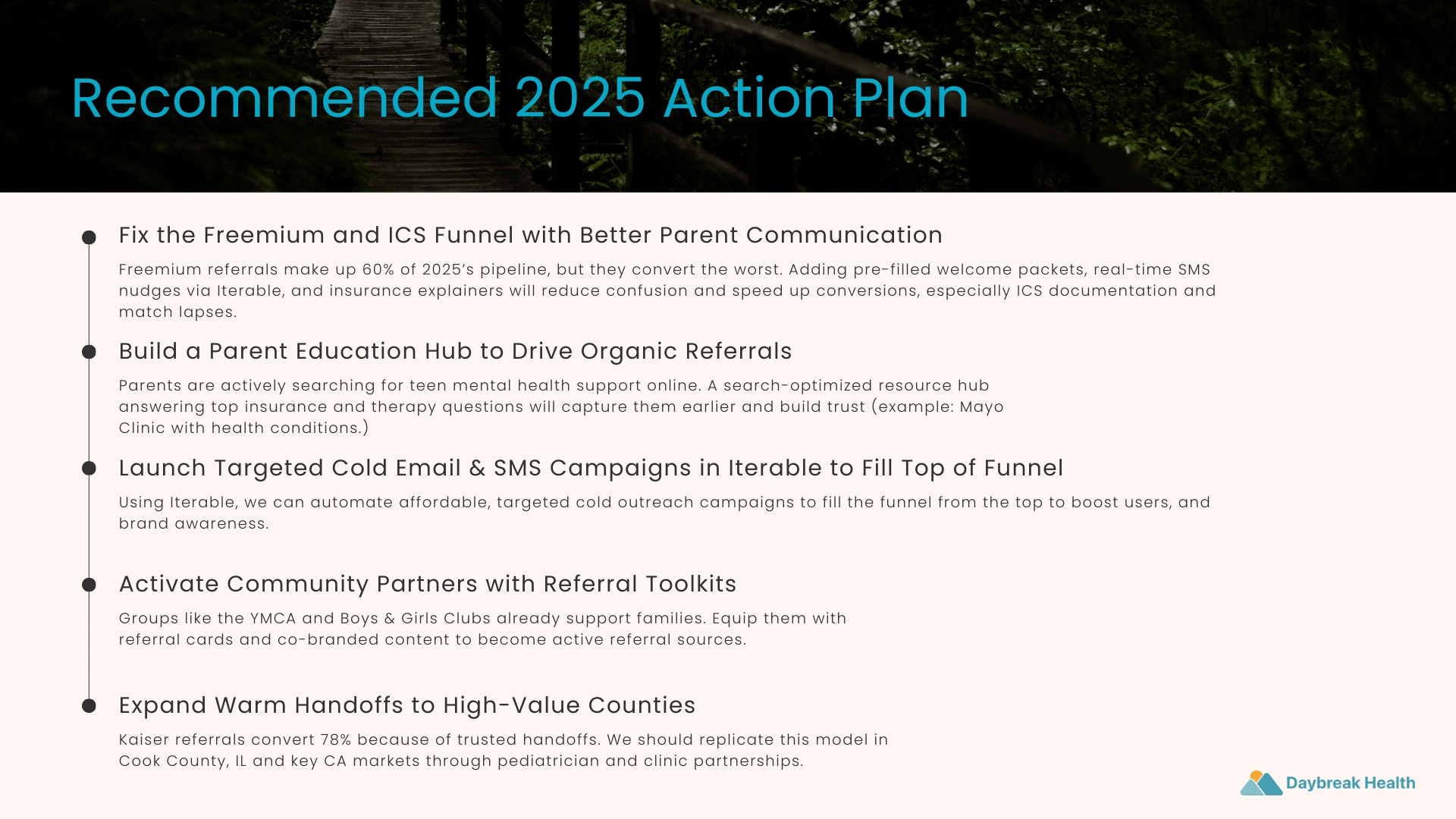
Slide 10

Slide 11
Case Study 2 - Cartwheel
Context
Cartwheel Care is a mental health provider that partners with K–12 schools to deliver timely, high-quality therapy services to students. As they planned to expand across the Midwest, Cartwheel aimed to secure partnerships with 100+ school districts, reaching 20,000+ students. Their current acquisition channels were solid but not sufficient to meet ambitious growth targets for the 2025–26 school year.
As the ABM Strategy Lead, I was asked to develop a scalable outreach strategy to target key school district decision-makers and achieve measurable pipeline growth in under 90 days.
Strategy
My goal was to design a multi-touch, account-based marketing (ABM) plan to maximize relevance and intent-based engagement across the Midwest. The campaign prioritized high-value personas, including:
Superintendents
Directors of Student Services
CFOs
School board members
Key messaging was tailored around how Cartwheel supports district-wide mental health initiatives, meets funding compliance, and eliminates student waitlists.
Data & Execution
The ABM campaign focused on four core pillars:
Outbound Campaigns – personalized email nurtures and LinkedIn InMail targeting key decision-makers, supported by curated lists in 6Sense.
Content & Events – webinars co-hosted with mental health professionals, community-led AMAs on Reddit, and educational blog resources for stakeholder buy-in.
Attribution & Tracking – a U-shaped attribution framework integrated with HubSpot and Google Tag Manager to properly credit awareness and conversion efforts.
Sales Enablement – lead scoring rules built in HubSpot to trigger SDR follow-ups for qualified accounts with a standardized 24-hour SLA.
Budget Considerations:
Total campaign budget: $18,000–$21,000
Tools included HubSpot, 6Sense, Lemlist, and standard marketing infrastructure.
Projected outcomes:
50 MQLs
20 SQLs
10 new school district contracts within three months
Deliverables & Presentation
I developed a detailed strategic memo outlining funnel design, persona targeting, content recommendations, and campaign sequencing, alongside a C-suite presentation that highlighted KPIs, pipeline forecasting, and budget breakdowns.

Slide 1
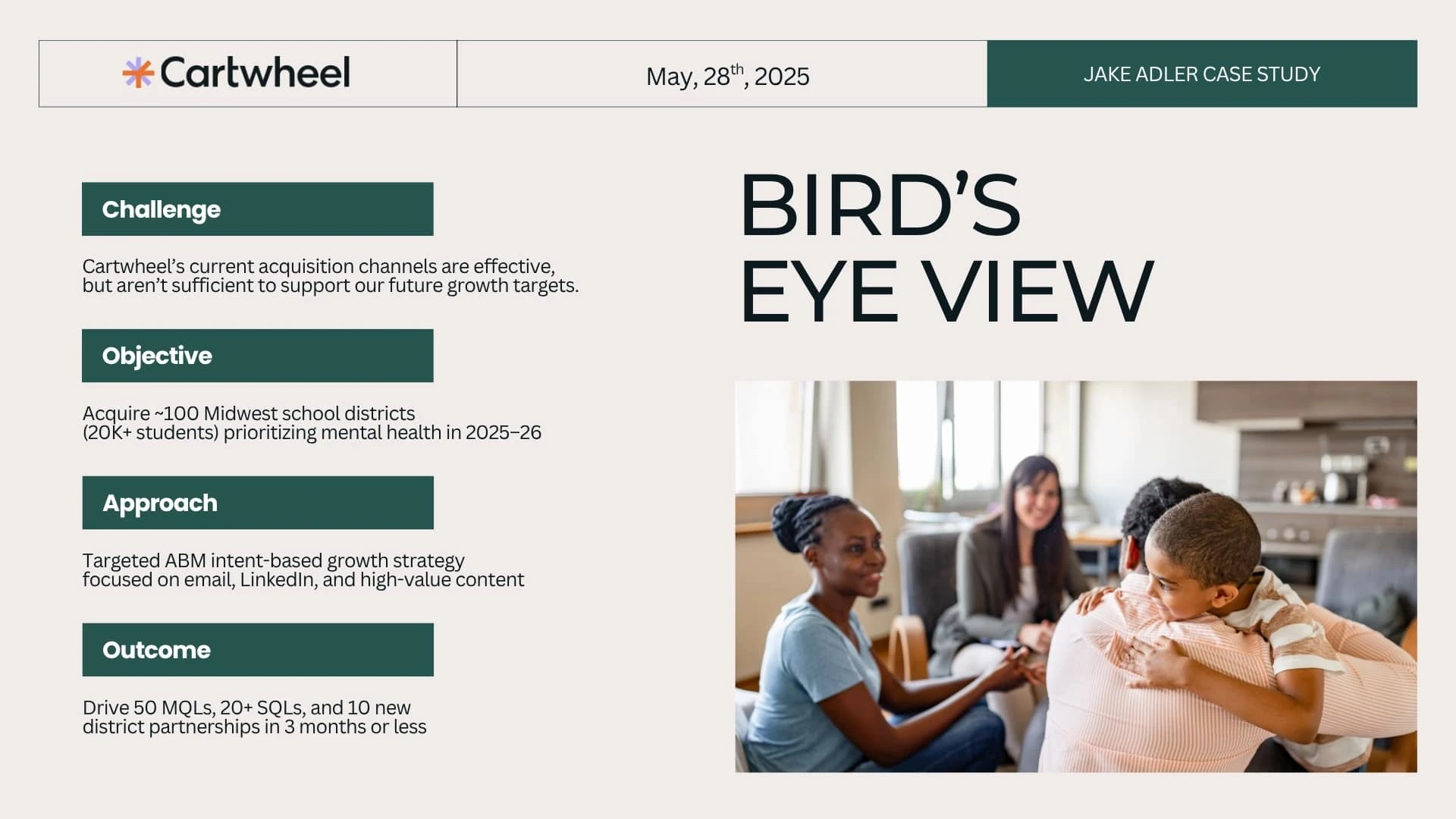
Slide 2
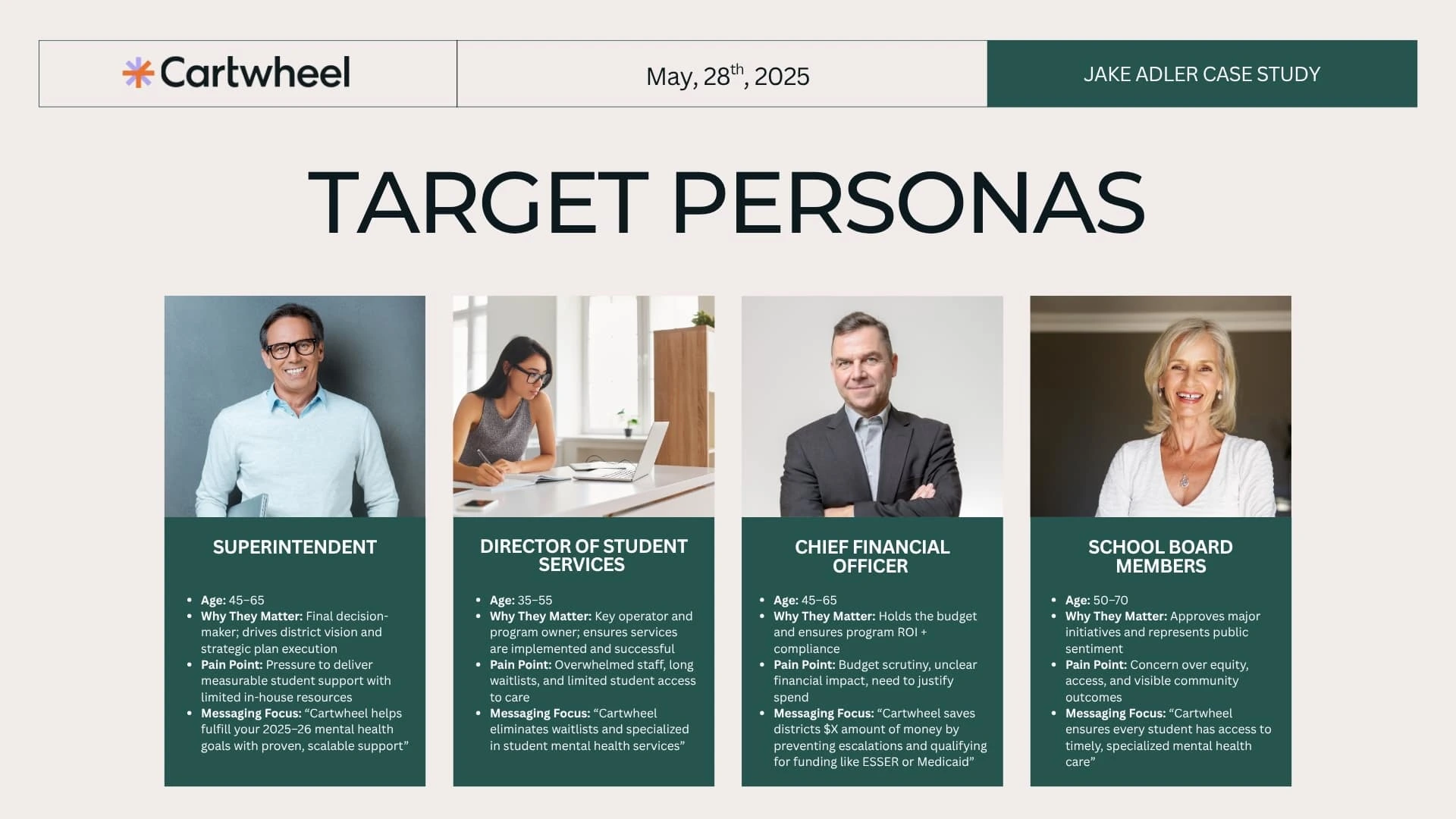
Slide 3
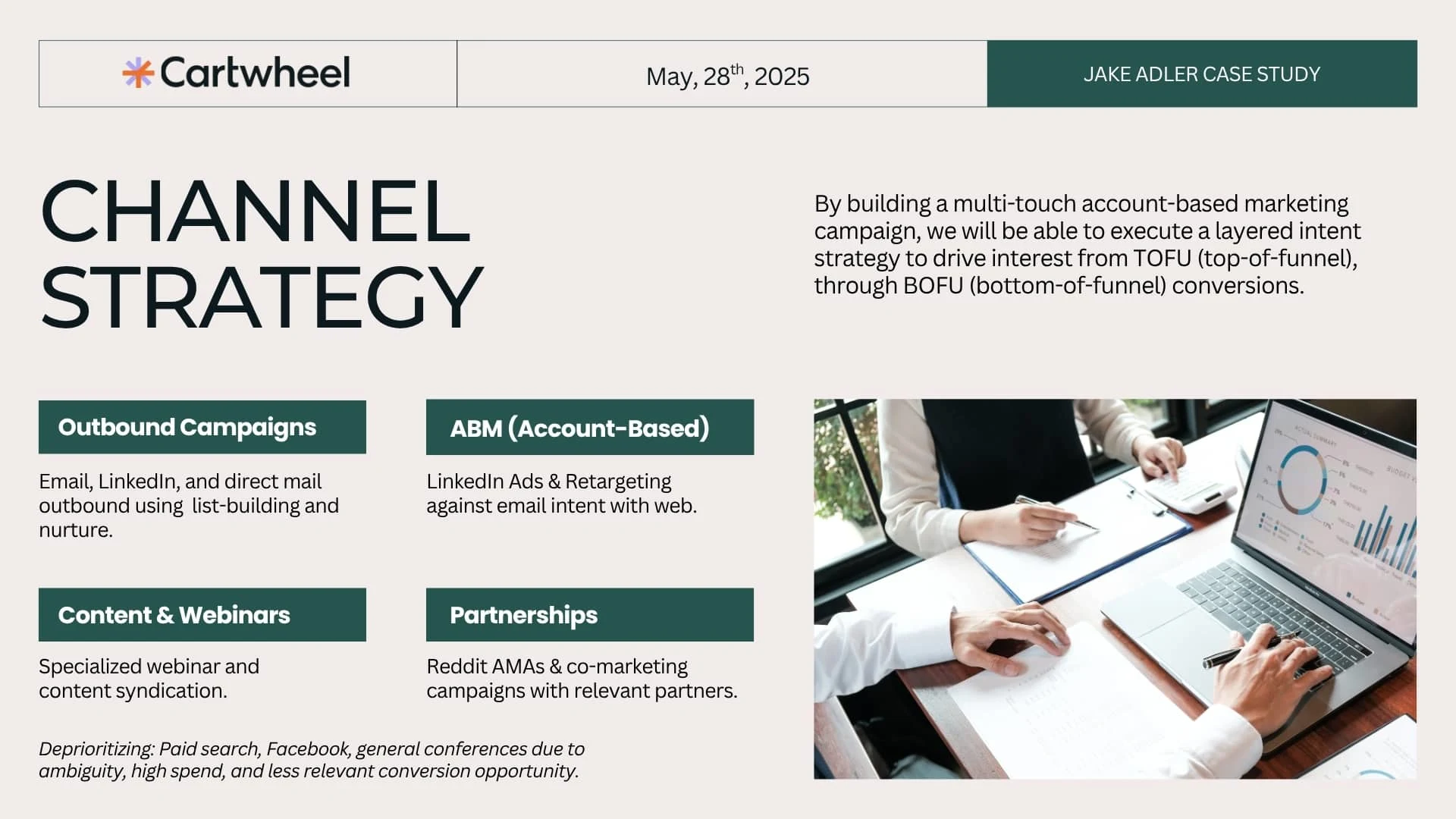
Slide 4

Slide 5
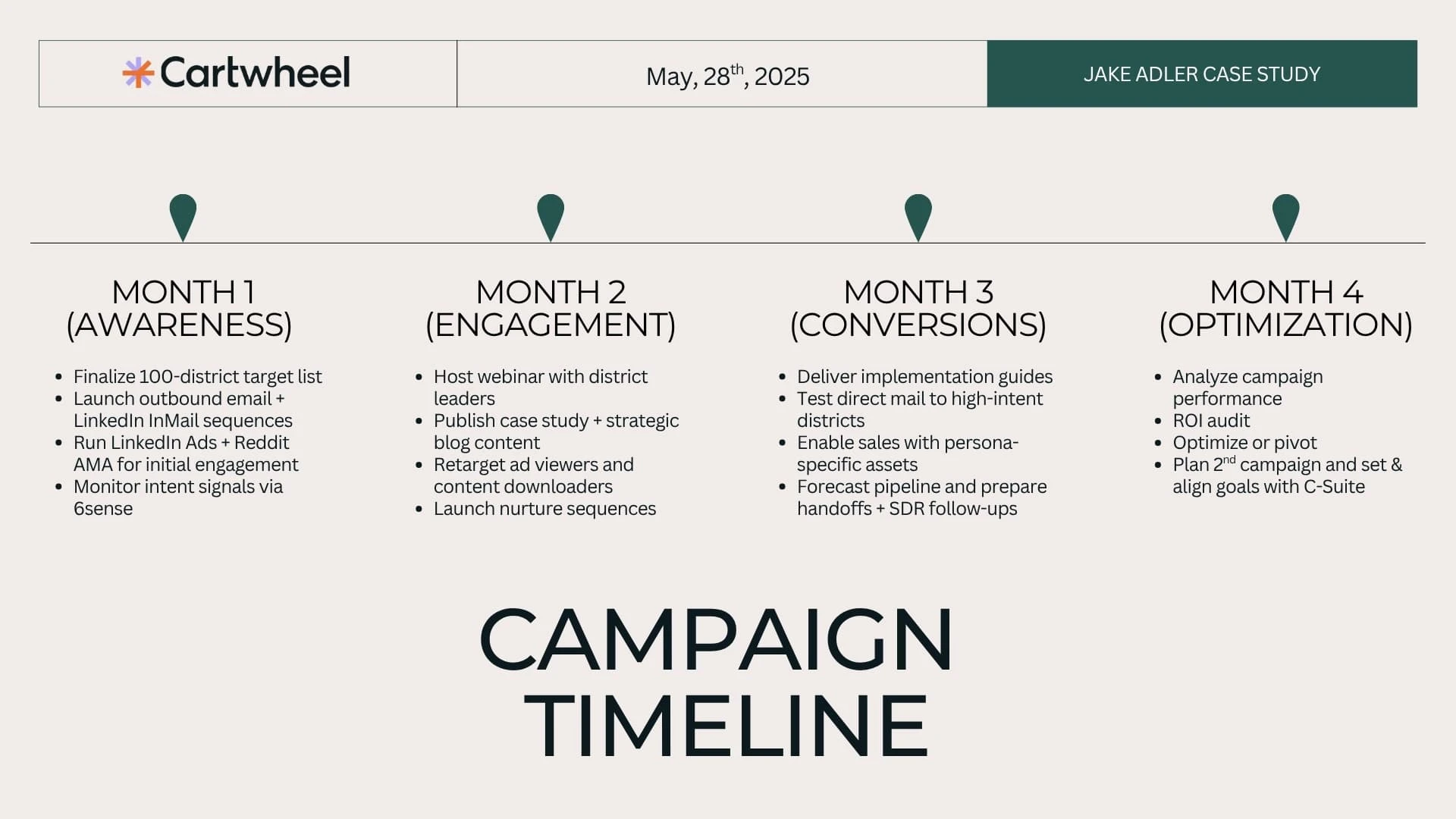
Slide 6

Slide 7
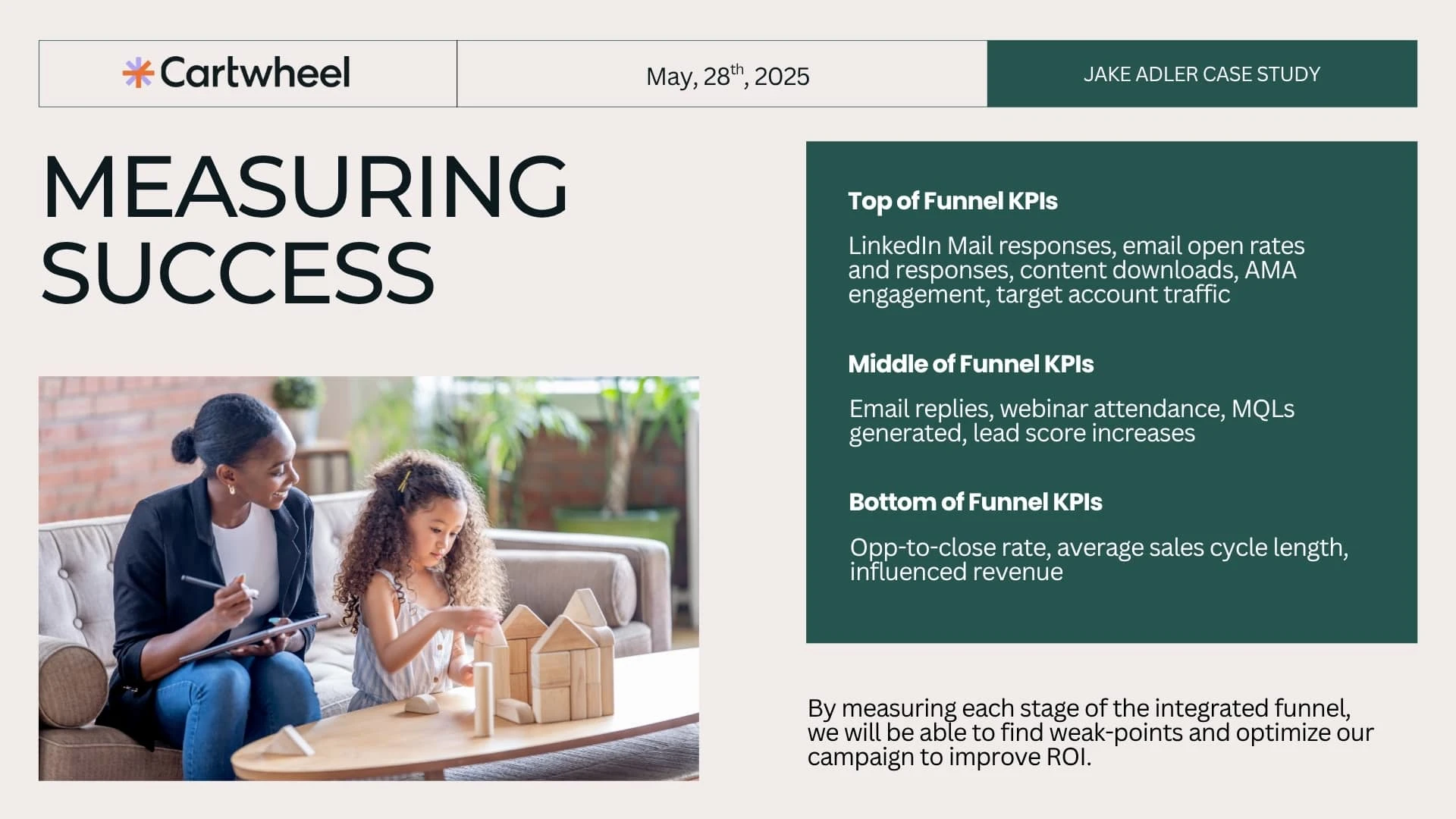
Slide 8
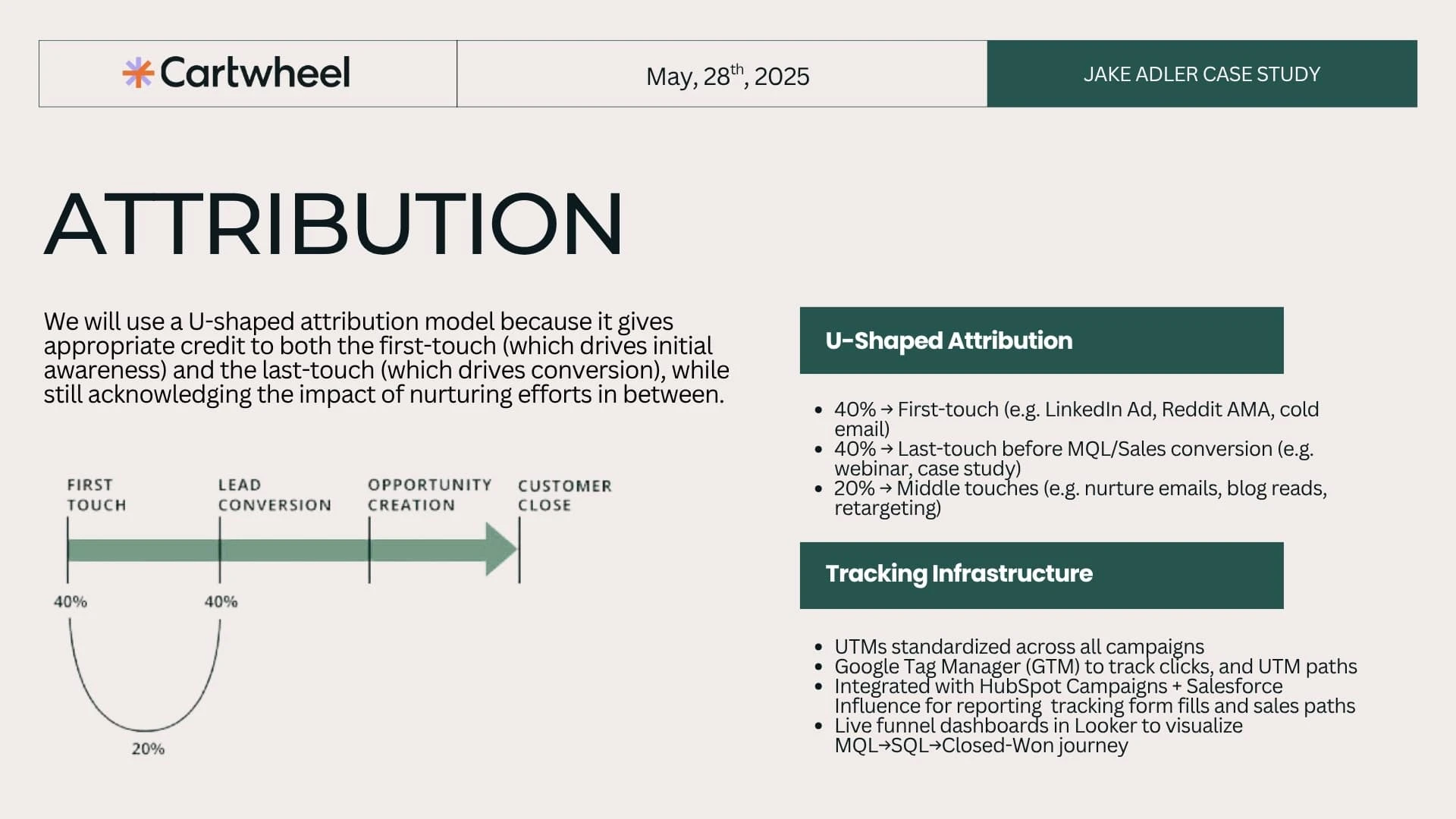
Slide 9
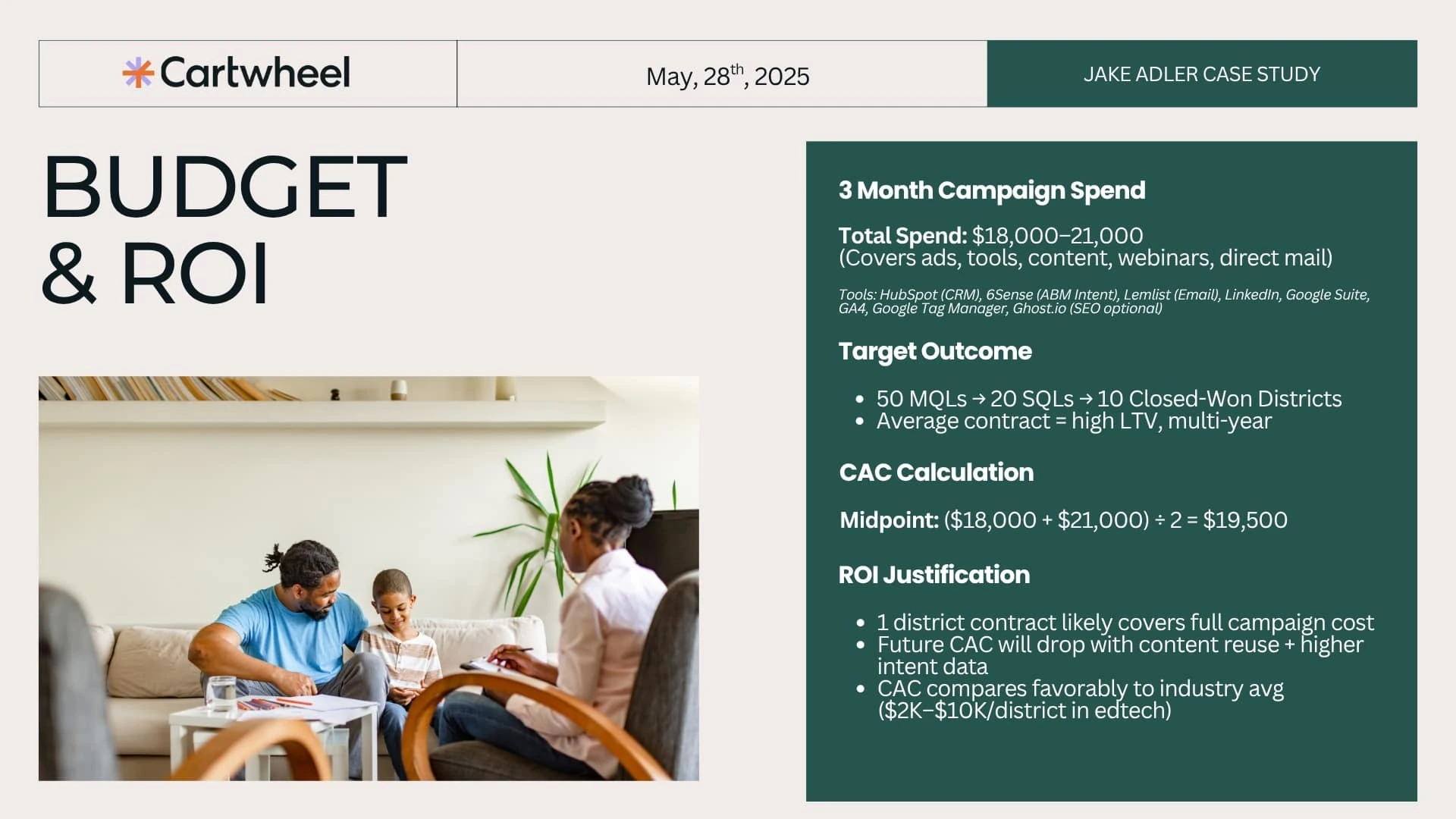
Slide 10
Case Study 3 - NicklPass
Context
NICKLpass provides businesses with a digital multi-team pass for instant access to over 100 paid news subscriptions without the need for passwords or facing paywalls. The company primarily targets Chief Communications Officers (CCOs) at Fortune 1000 companies, leveraging a “land and expand” strategy, where initial contracts range from $7,000 - $10,000, with potential growth up to $100,000.
As the Marketing Strategy Lead, my role was to develop a scalable cold email marketing strategy that would:
Double or triple the number of qualified sales meetings (from 2-3 to 6-9 meetings per week).
Primarily connect with CCOs at Fortune 1000 companies.
Reduce the land & expand conversion time within organizations.
Gather feedback on product challenges and reasons for lost deals.
Given a $5,000/month marketing budget, my challenge was to build a highly efficient email marketing system that could generate consistent and predictable leads without relying on additional marketing channels.
Data & Strategy
Key Metrics & Assumptions
Based on previous SaaS experience with a similar strategy and product price point, I estimated the following funnel performance to hit conversion targets:
Email Open Rate: 15%
Email Response Rate: 3%
Meeting Conversion Rate: 50%
Prospects Needed to Generate 9 Meetings per Week: 4,000
Using this framework, I structured the campaign around HubSpot CRM automation, leveraging targeted prospect lists sourced through ZoomInfo and specialized freelancers.
Cold Email Strategy & Execution
I developed a four-stage campaign execution plan:
Preparation
Set up HubSpot CRM and configure automated email sequences.
Integrate ZoomInfo for precise CCO targeting.
Create prospect segments based on industry, company size, and role.
Creation
Draft high-converting email sequences, including subject lines optimized for open rates.
Design supporting sales collateral (one-pagers, case studies, and ROI breakdowns).
Develop A/B testing framework to refine messaging over time.
Execution
Launch weekly campaigns targeting 4,000 CCO prospects.
Provide marketing assets to the sales team for seamless MQL handoff.
Track engagement metrics to optimize responses.
Evaluation & Optimization
Every two weeks, analyze open rates, response rates, and meeting conversions.
Optimize messaging based on real-time feedback from responses.
Adjust targeting criteria to improve efficiency.
Projected Budget Allocation
Expense Monthly Cost
HubSpot CRM $1,080
ZoomInfo Leads $1,360
Canva (Marketing Assets) $15
Total
$2,455 (coming in $2,545 under budget)
Deliverables: Memo 1 & 2
I developed and implemented a comprehensive marketing strategy that outlined:
Cold email templates & personalization tactics to maximize response rates.
A conversion funnel breakdown to track performance at each stage.
A data-driven email automation plan designed for scaling outreach efforts.
A feedback loop for sales team insights, ensuring continuous refinement.
Deliverables & Presentation
I presented my findings and strategy to NICKLpass leadership, outlining a 3-month execution roadmap with measurable KPIs to evaluate success.
I designed and presented my funnel analysis, and memo findings to a panel of C-Suite executives at the company.
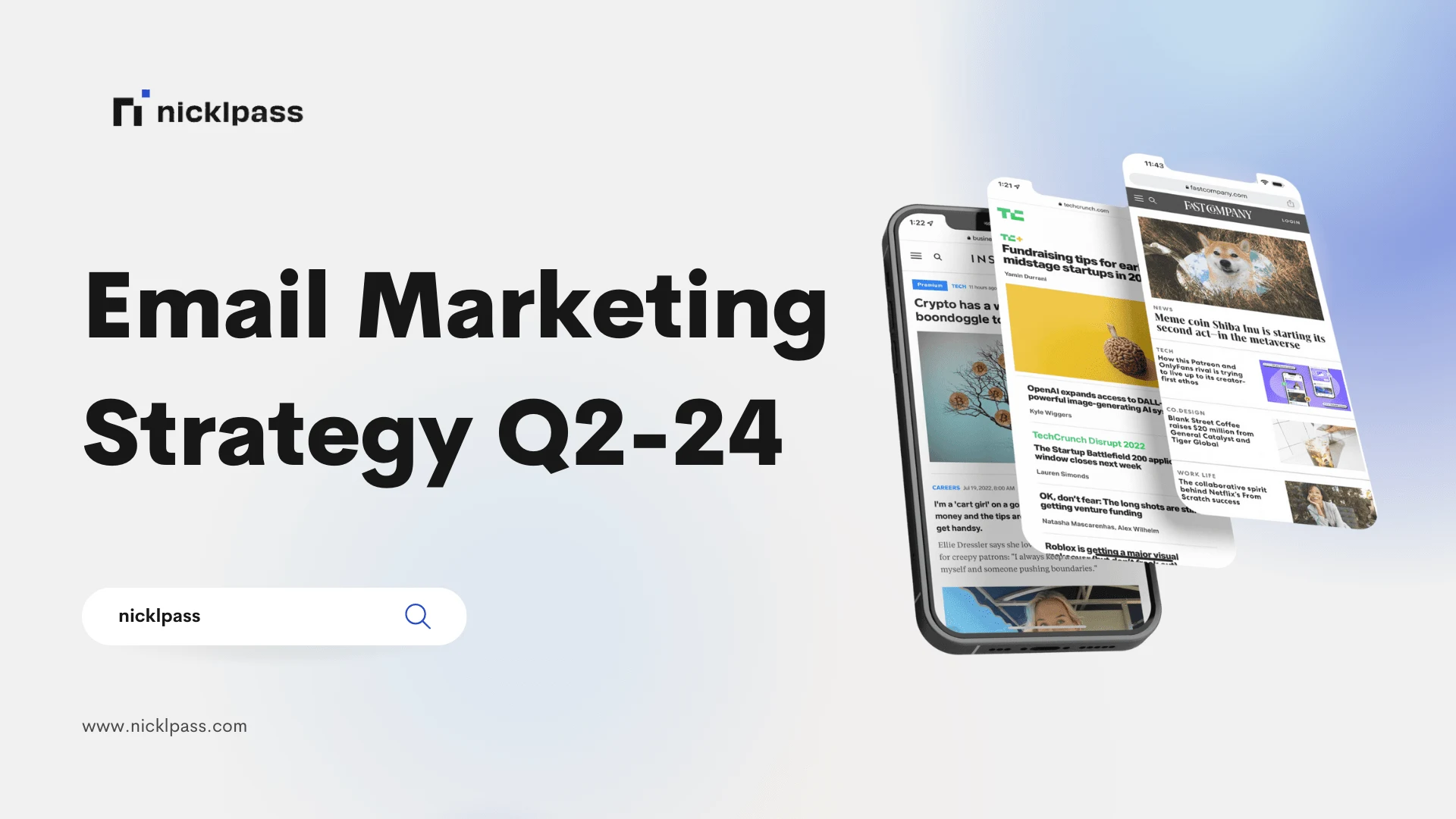
Slide 1

Slide 2

Slide 3
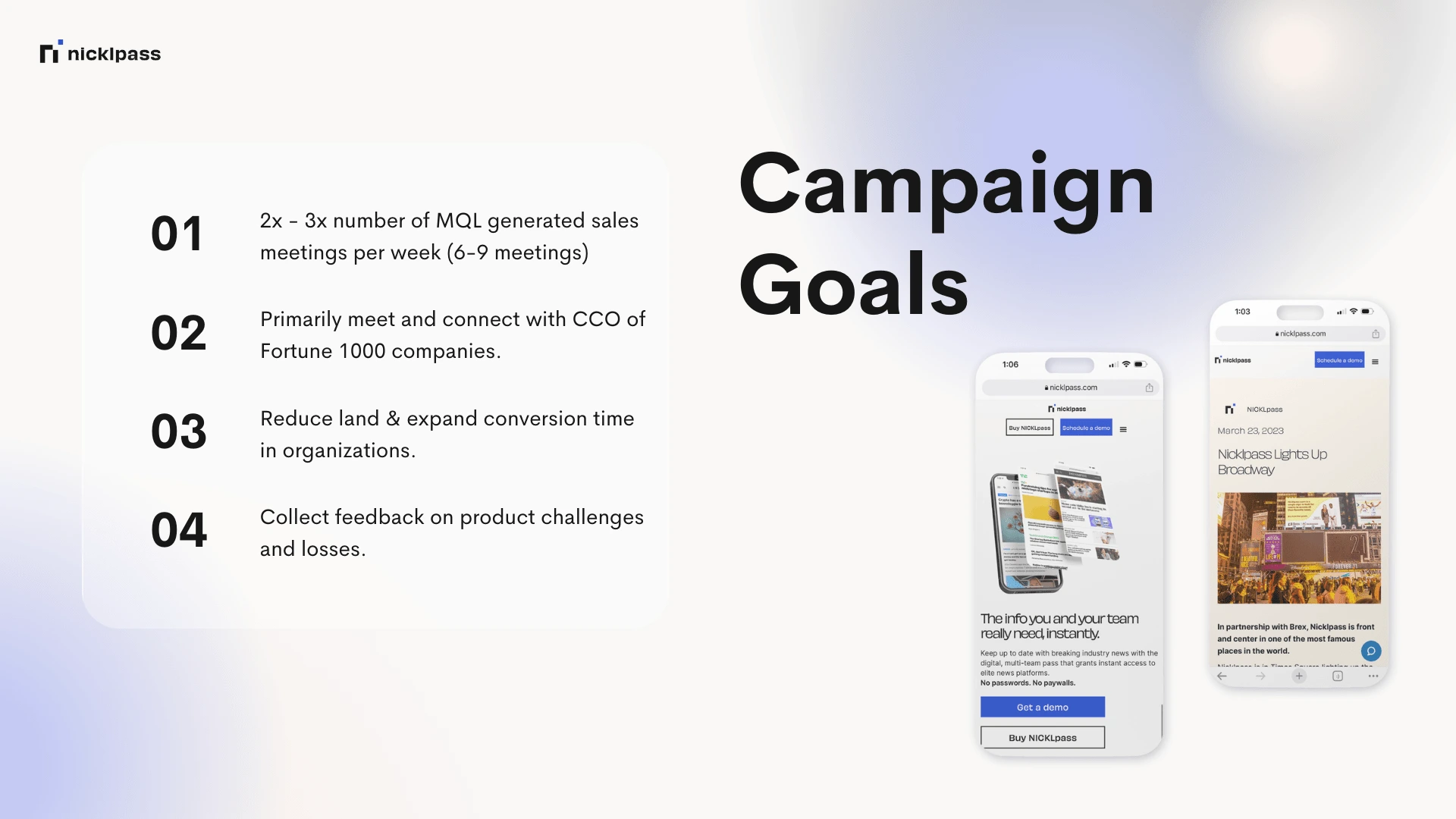
Slide 4
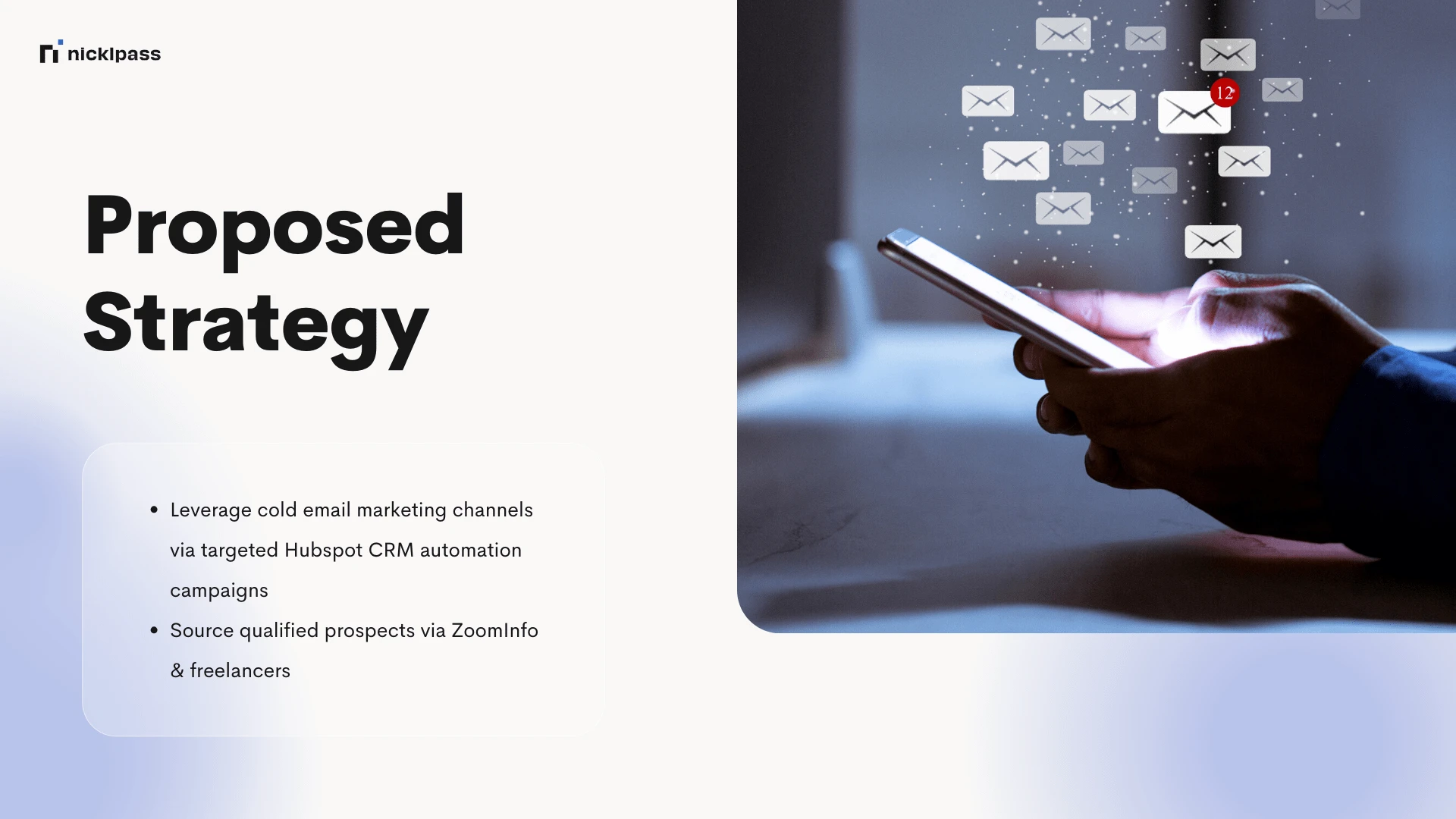
Slide 5
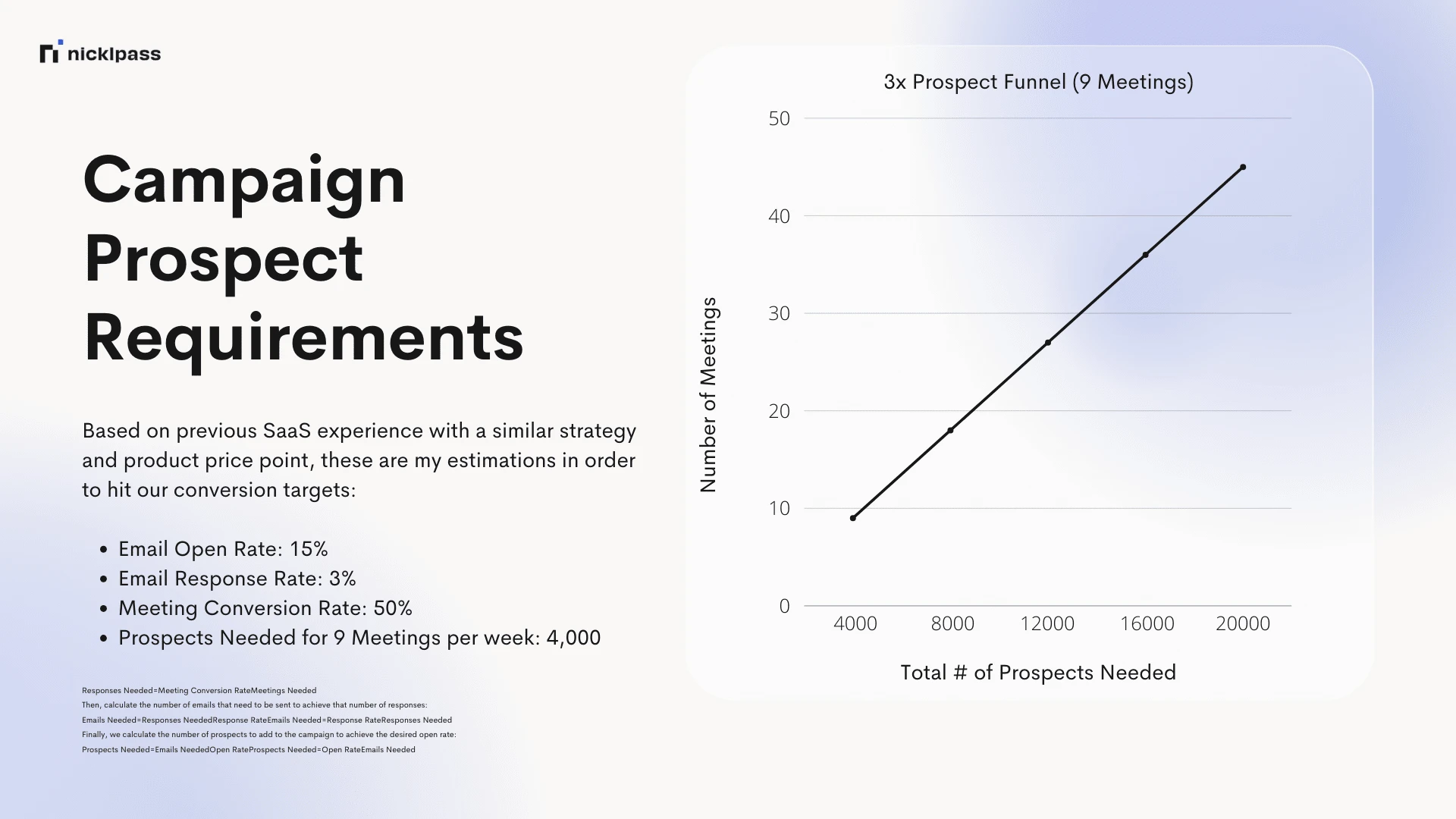
Slide 6

Slide 7
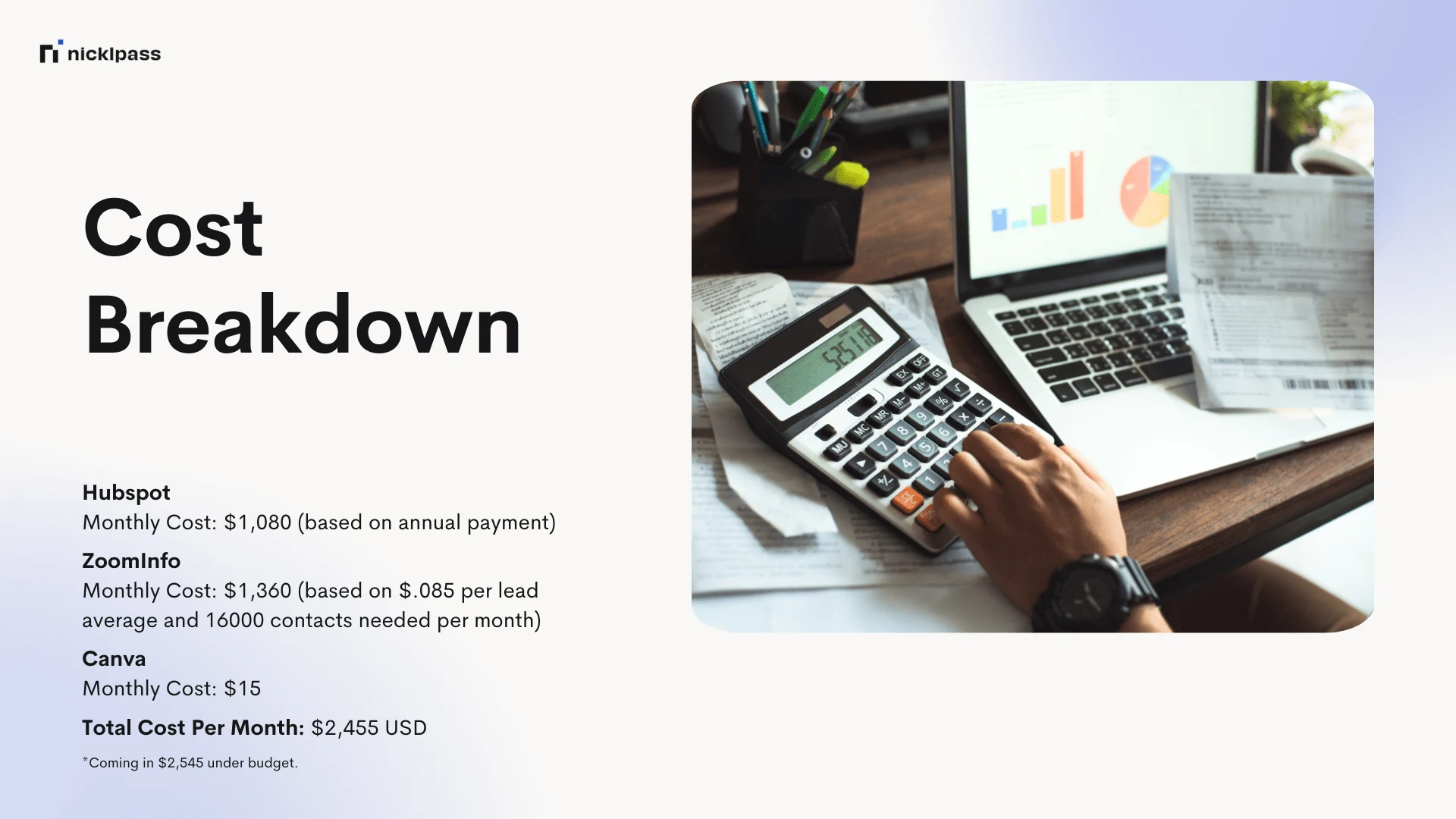
Slide 8

Slide 9
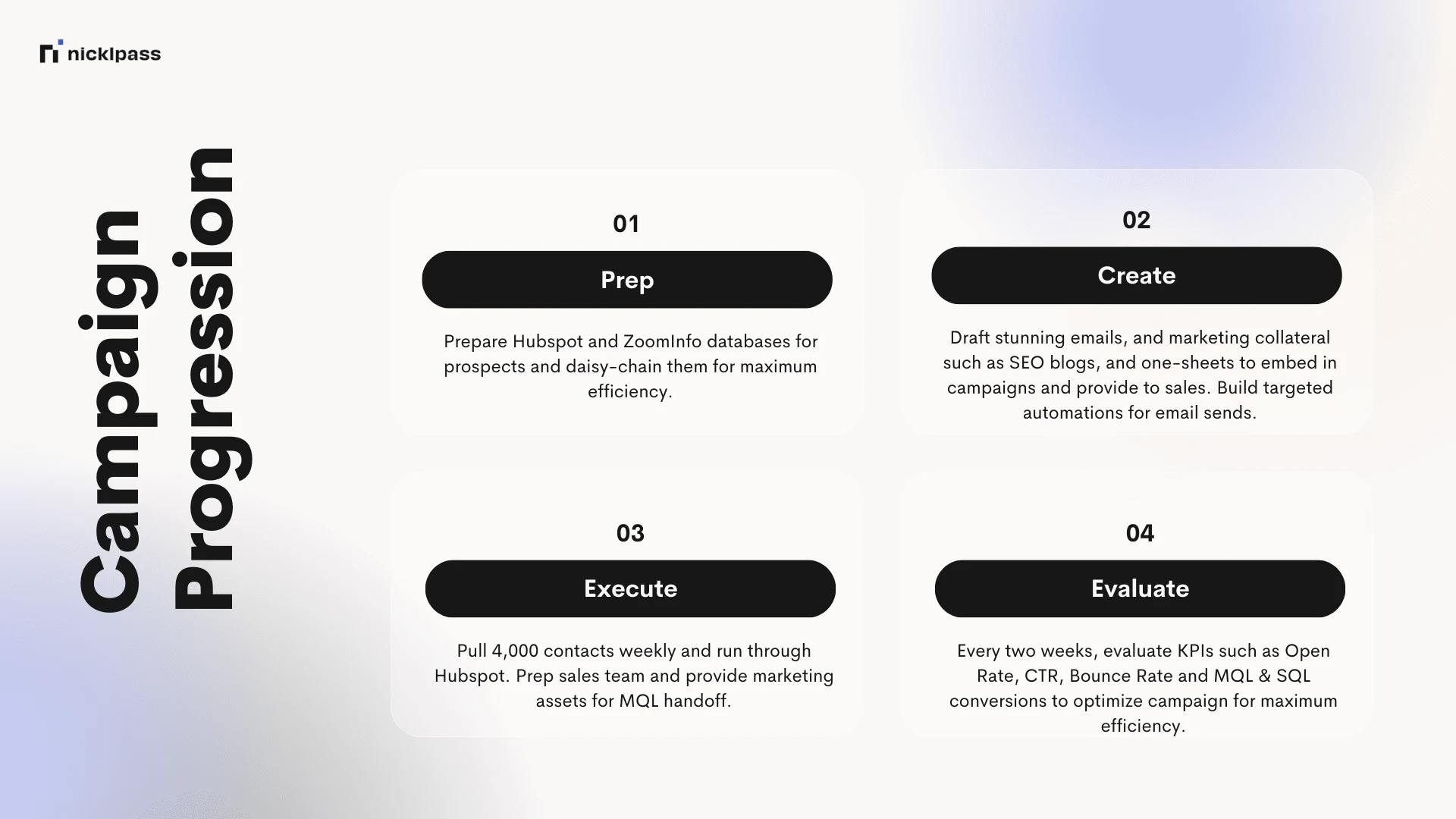
Slide 10

Slide 11
Case Study 4 - Homebase
Context
Homebase is a workforce management platform that provides scheduling, time tracking, payroll, and team communication tools for small businesses. The company relies on Google Ads to drive sign-ups, with a primary focus on Marketing Qualified Leads (MQLs) at a target CPA of $350.
As the Growth Marketing Analyst, my role was to analyze Google Ads performance and provide recommendations to improve efficiency and scale MQL acquisition. My key objectives included:
Identifying high-performing campaigns and scalability opportunities.
Detecting underperforming ad groups and providing actionable optimization strategies.
Recommending budget reallocations to maximize ROI.
Suggesting one non-search channel for expansion beyond Google Ads.
Data
The dataset provided contained Google Ad campaign data from March and April 2023, detailing ad spend, conversions, CPA, and lead-to-MQL rates.
What’s Working
Several branded campaigns demonstrated strong performance, with high lead-to-MQL conversion rates and below-target CPAs, indicating potential for further budget allocation and scaling.
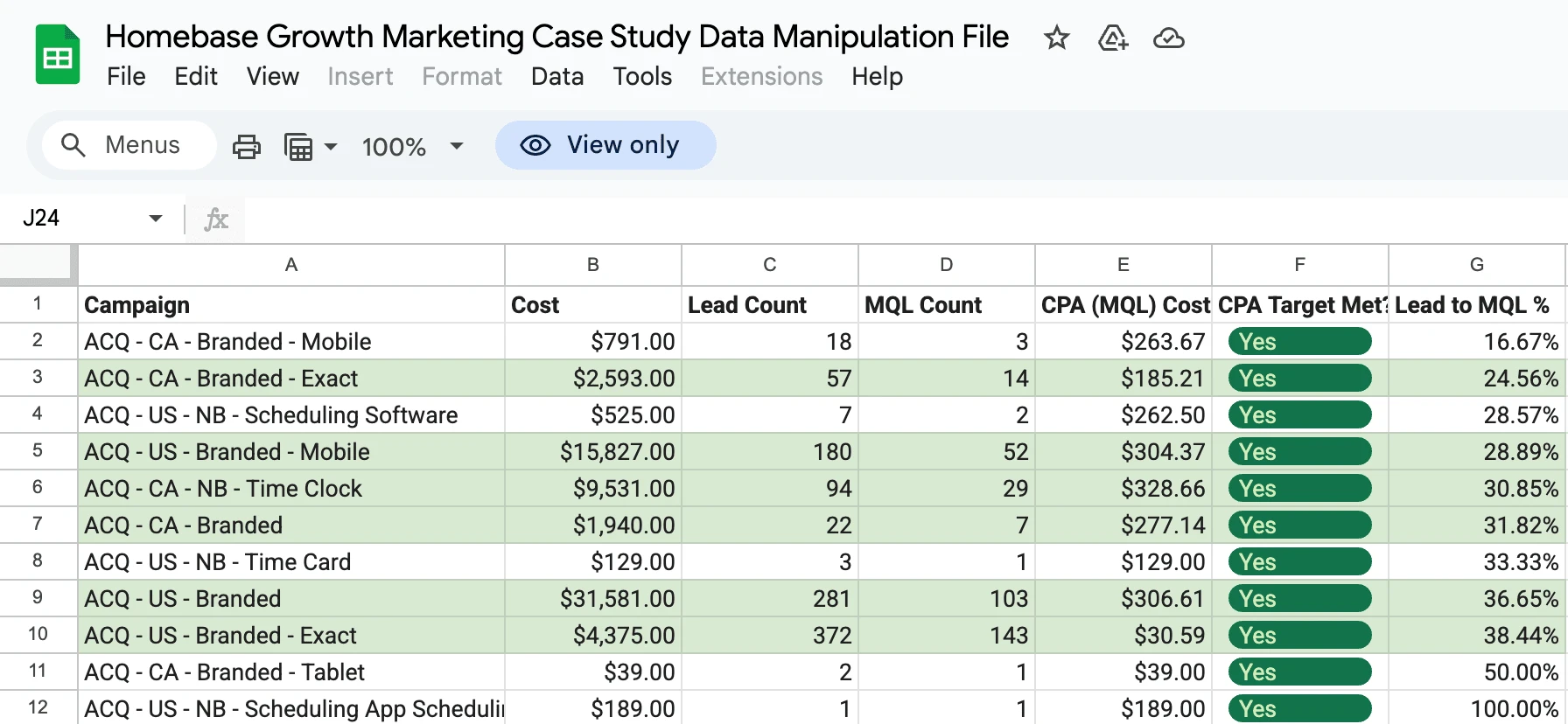
Homebase Successful Campaigns Data
What’s Not Working
Pinned Responsive Search Ads (RSAs)
Campaigns using pinned RSAs consistently underperformed, suggesting ineffective ad copy and targeting.
Non-Branded Campaigns
Broad keyword targeting resulted in higher CPAs and low conversion rates, leading to inefficient ad spend.
Optimization & Improvement Strategy
To maximize efficiency and ROI, I developed a three-phase optimization plan:
1. Reallocate Budget to High-Performing Campaigns
Rationale: Maximizing spend on campaigns with low CPAs and strong MQL conversion rates ensures optimal ad efficiency.
Action: Increase investment in branded campaigns with proven success.
2. Optimize Underperforming Campaigns
Rationale: Campaigns with CPA above $350 or zero conversions require refinement or pausing.
Action: Adjust broad match targeting, add negative keywords, and implement brand-focused messaging to improve conversions.
3. A/B Test Ad Copy & Landing Pages
Rationale: Better alignment between user intent, ad messaging, and landing pages can improve conversion rates.
Action:
Test new ad variations focusing on clearer value propositions (e.g., "Save 10+ Hours Weekly with Our Scheduling App").
Optimize landing pages by improving CTAs and page load speeds.
Missing Data & Additional Insights
To further refine Google Ads performance, I identified key missing data points that would enhance decision-making:
Search Term Reports
Helps analyze which queries drive conversions and where to implement negative keywords to eliminate wasted spend.
Landing Page Performance Metrics
Understanding bounce rates and conversion rates would provide insight into how well ads translate into sign-ups.
Demographic Performance Data
Identifying which audience segments convert best (by age, device, and location) would allow for targeted bid adjustments.
Expansion Recommendation: LinkedIn Retargeting
Given Homebase’s small business audience, I recommended LinkedIn Ads as a non-search channel for expansion.
Why LinkedIn?
Business decision-makers frequently use LinkedIn for hiring and networking.
Retargeting high-intent website visitors from Google Ads would reinforce brand awareness and drive additional conversions.
Execution Plan
Use Google Ads audience data to build LinkedIn retargeting lists.
Repurpose best-performing branded ad creatives for LinkedIn Sponsored Content.
Test lead-gen forms vs. website conversion ads to optimize performance.
Deliverables & Presentation
I compiled my analysis and strategic recommendations into a five-page presentation and presented my findings to the Homebase marketing team. This included campaign insights, optimization strategies, and a roadmap for expansion into LinkedIn retargeting.
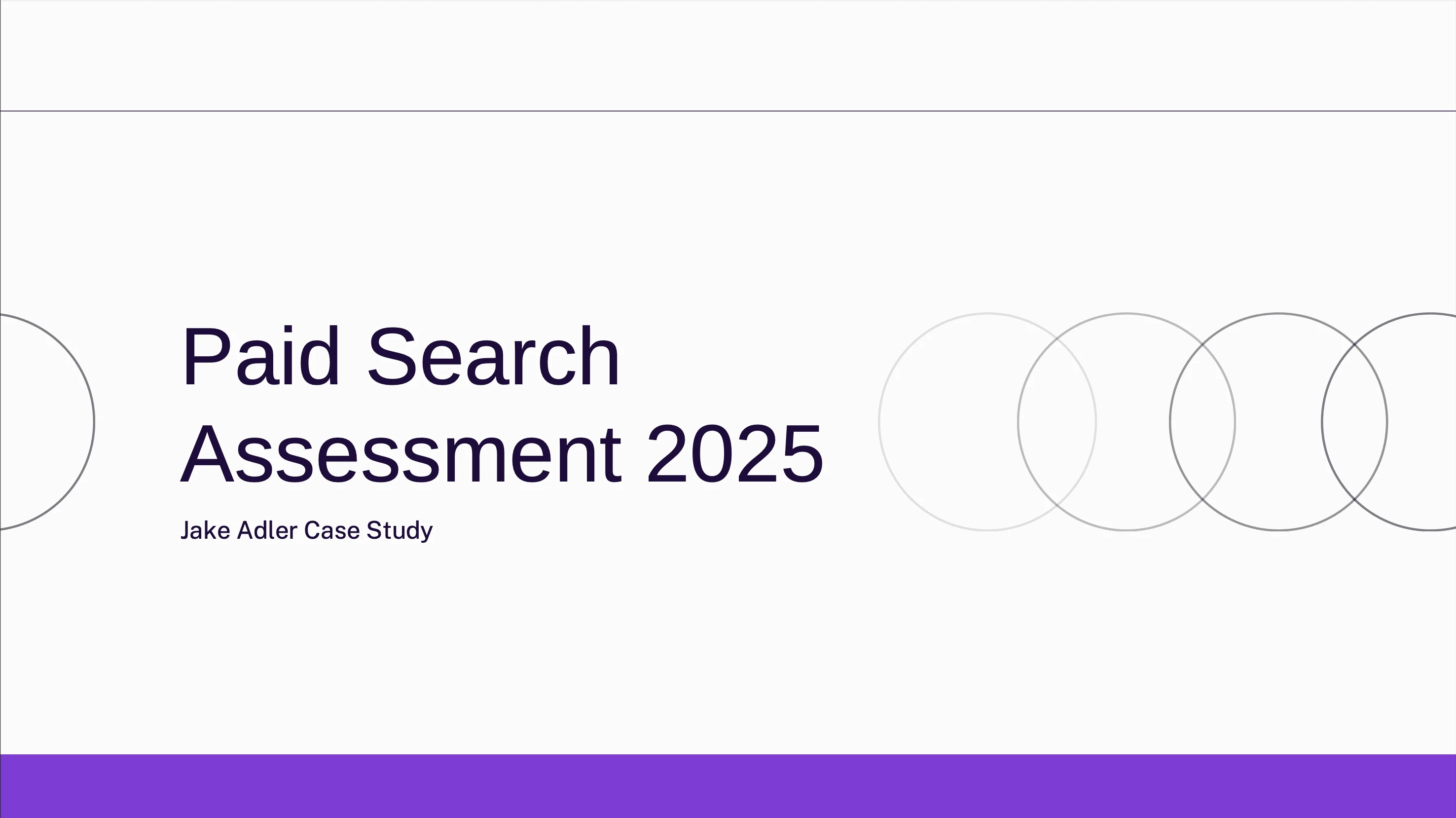
Slide 1
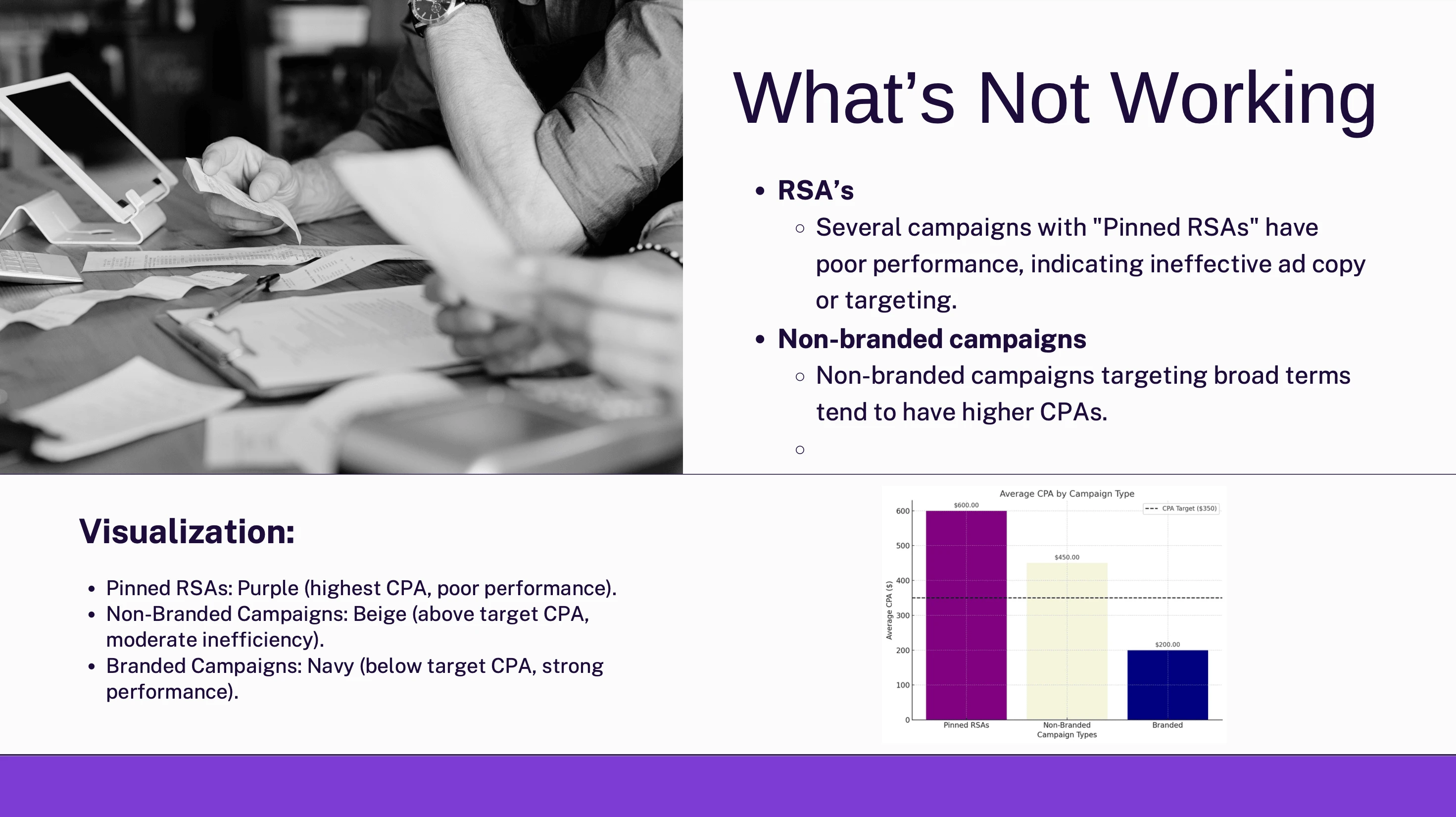
Slide 2
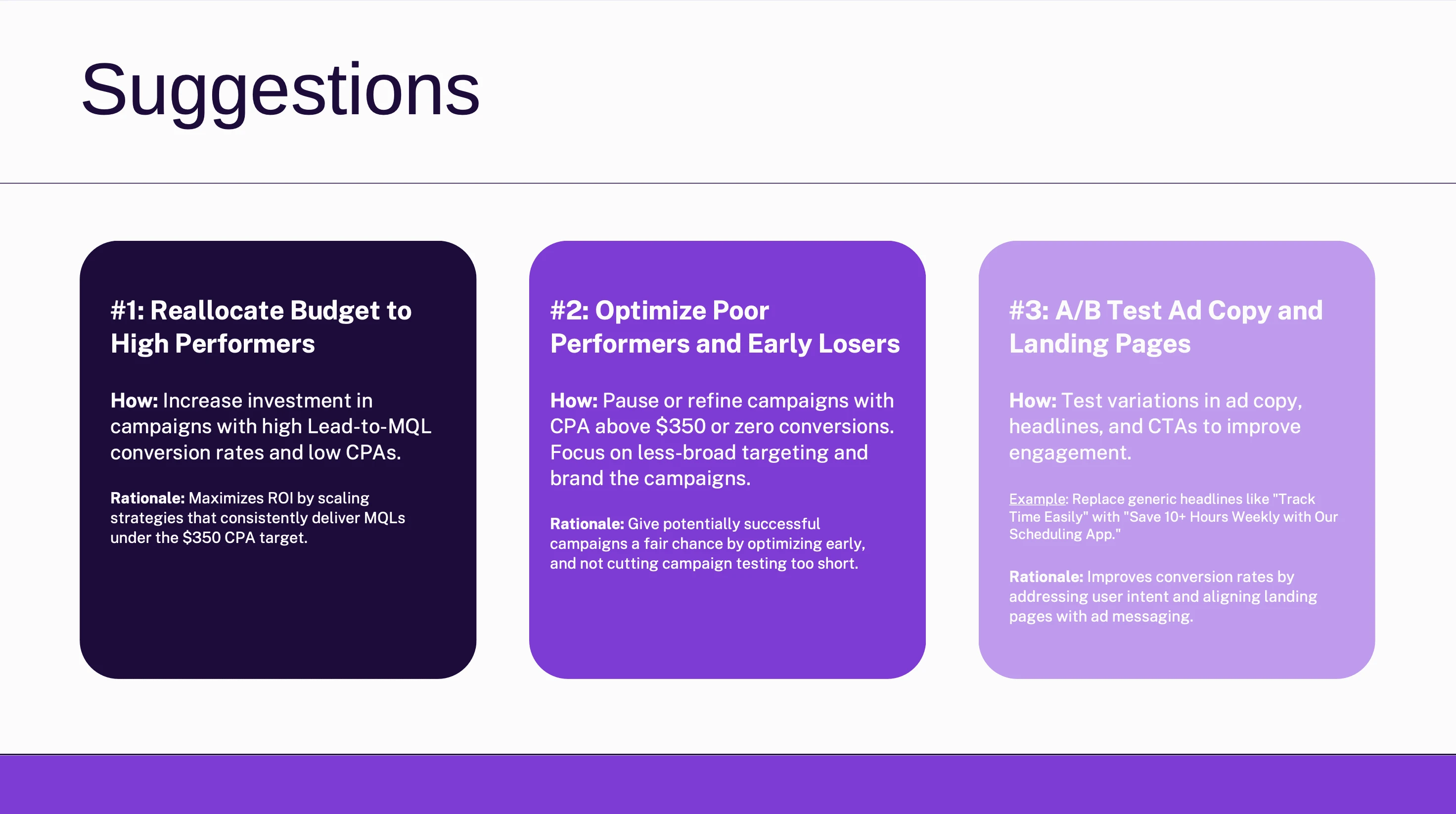
Slide 4
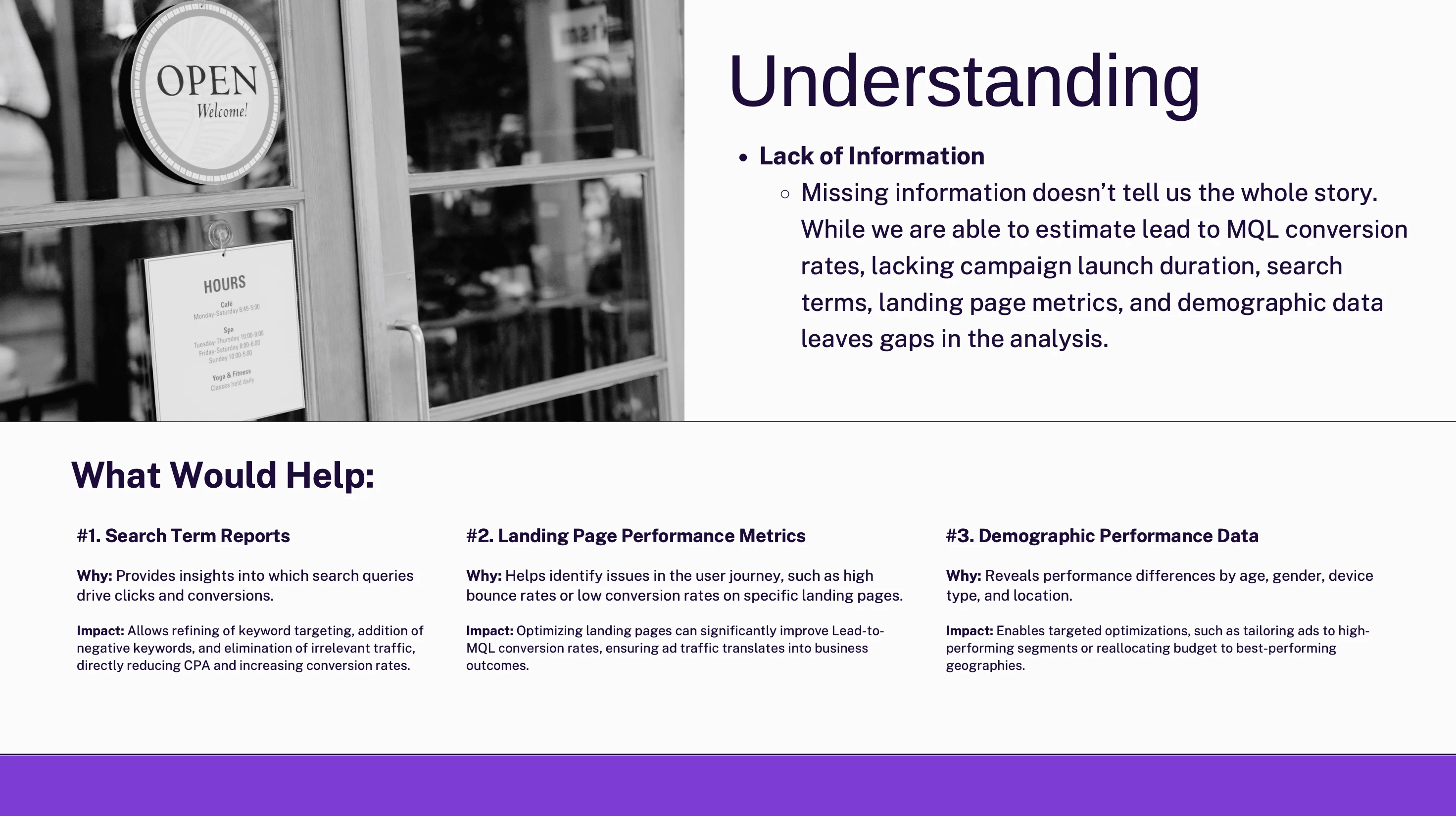
Slide 5
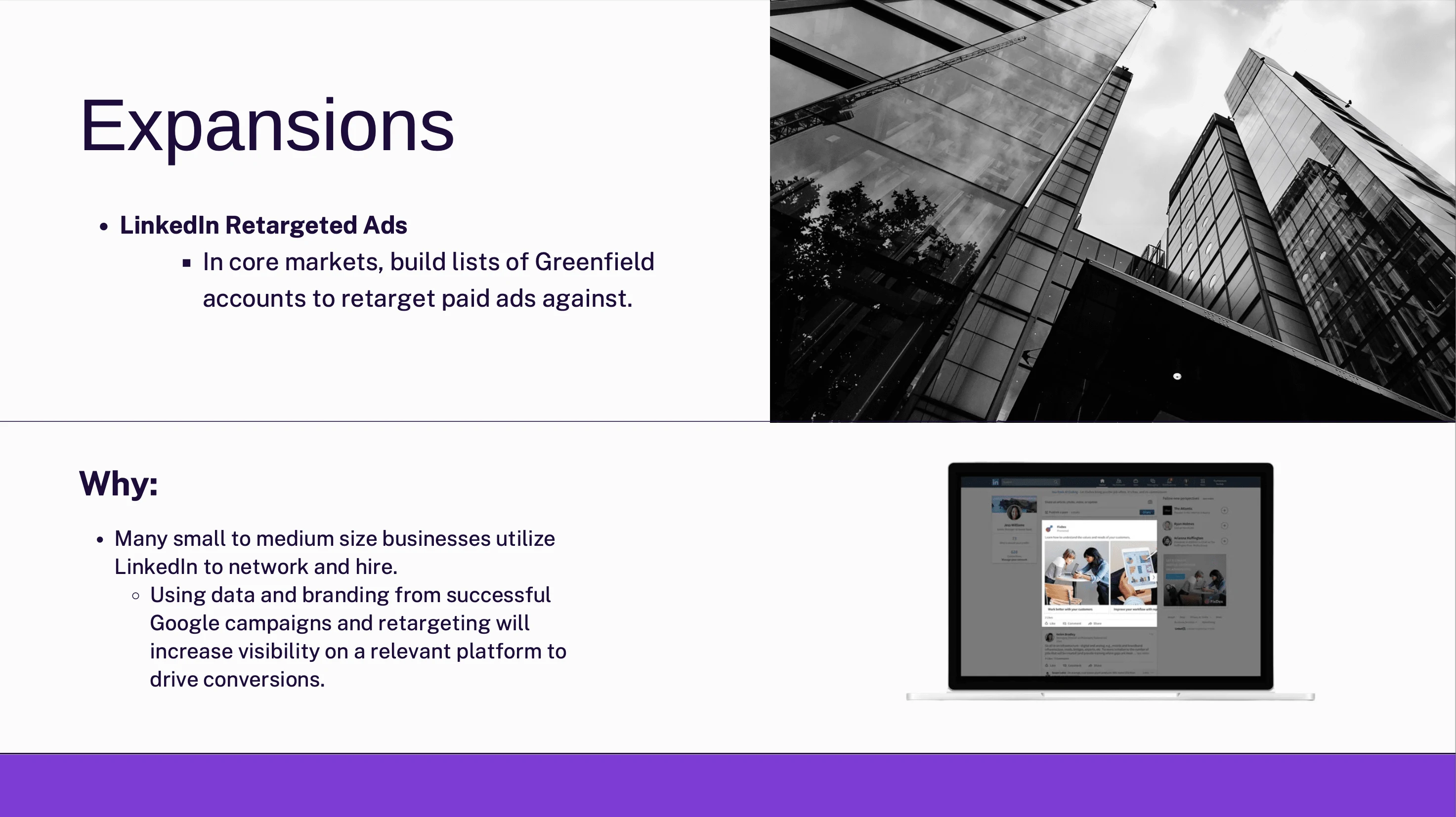
Slide 6
Case Study 5 - Daysmart
Context
Daysmart is a B2B software provider specializing in recreation and facility management solutions. The company has struggled to engage 500 ice rink businesses in its Salesforce database, as previous sales call and email sequences failed to generate demos. These businesses remain unengaged leads with no prior product demo experience.
As the Demand Generation Manager, my goal was to re-engage this audience and achieve a 25% conversion rate (125 businesses) requesting a product demo. The challenge was to develop a multi-channel marketing campaign leveraging email, retargeting, and direct mail to drive conversions.
Strategy & Key Findings
Core Campaign Objectives
Reignite engagement with 500 dormant leads.
Drive 125 demo sign-ups within 10 days of campaign launch.
Leverage a multi-channel approach to reach ice rink operators effectively.
Core Messaging & Value Proposition
Headline: “Save 20% on Operations Costs in 2025 with Sawyer’s Easy-to-Use Toolset.”
Value Proposition:
Sawyer helps ice rink operators save time and money by automating scheduling, payments, and facility management.
Customers save 20% on operational costs on average, with a 10-minute setup to get started.
Call-to-Action (CTA) Examples:
“Try Sawyer for Free Today.”
“Join Our 15-Minute Demo and Get a $50 Gift Card + Free Trial.”
Execution Plan
To maximize conversions, I structured the campaign across three key distribution channels:
1. Email Marketing (Marketo)
Tech Stack: Marketo + Salesforce
Offer: Free trial if sign-up occurs within 10 days
Email Sequence & Messaging Strategy:
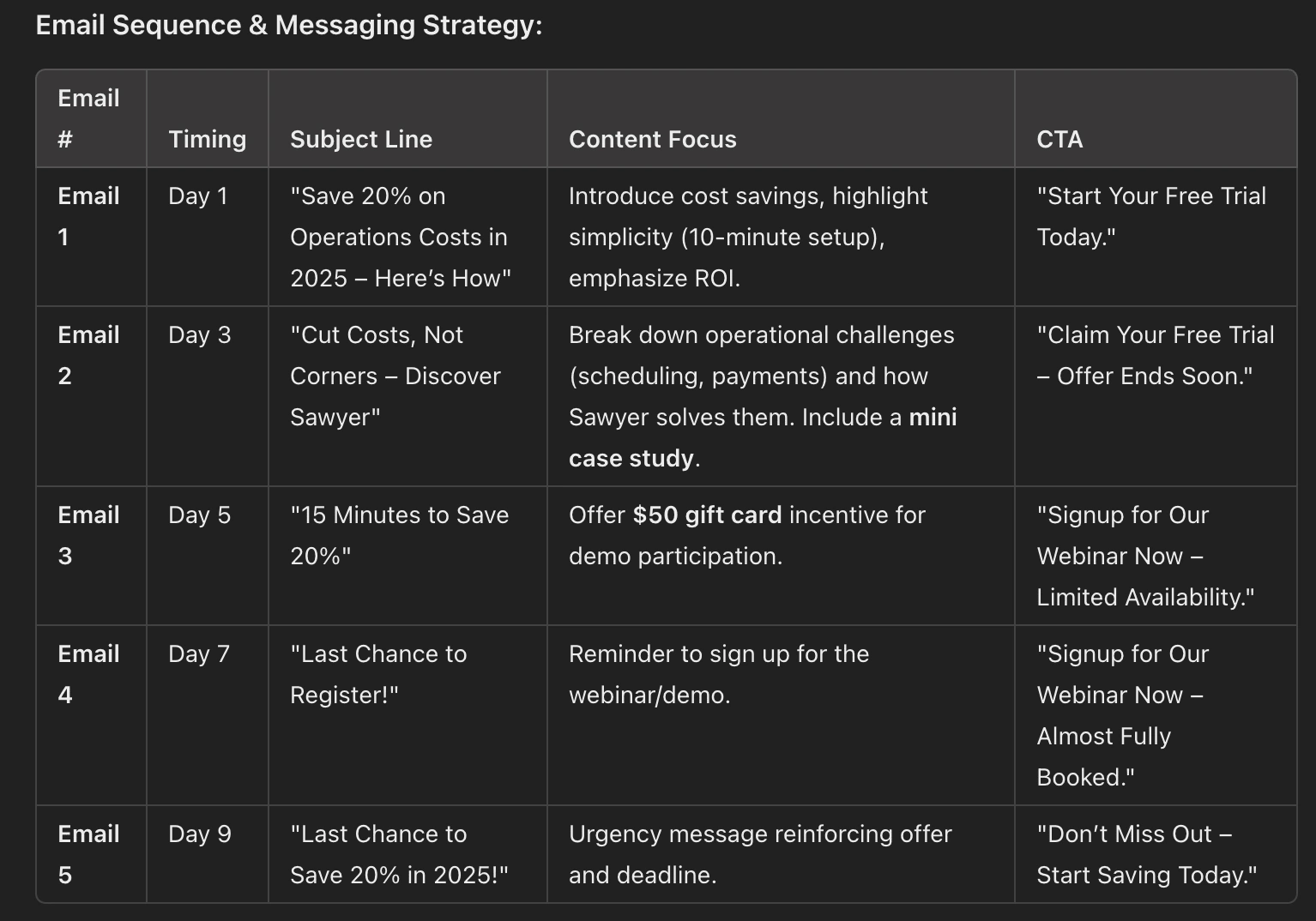
Email Messaging (ChatGPT was NOT used for the messaging, just to organize my portfolio)
2. LinkedIn Retargeting Ads
Tech Stack: LinkedIn + Salesforce
Offer: Free trial if sign-up occurs within 10 days
Targeting Strategy:
Use LinkedIn retargeting to re-engage Salesforce leads with high-intent messaging.
Focus on ice rink owners, operators, and senior management staff.
InMail Example:
"Hi [First Name], I hope all is well! I’ve been trying to connect regarding your ice rink operations. I’ve reviewed your business and believe we can save you over 20% annually. What’s your availability to chat this week?"
3. Direct Mail Campaign (Lob)
Mailer Design:
Ice rink-themed postcard with bold headline:
"Save 20% on Operations Costs with Sawyer – Start Saving Today!"
Offer & Tracking:
Include QR code linking directly to free trial sign-up page.
Incentive:
"Scan the code to claim an exclusive 10% discount on your first year of Sawyer!"
Resources & Budget Considerations

Resources & Budget
Key KPIs & Success Metrics
Email open, click-through, and conversion rates.
LinkedIn ad CTR and demo registrations from retargeted leads.
Webinar attendance and post-demo trial signups.
QR code scans and discount redemptions from direct mail.
Cost per lead (CPL) tracking.
Presentation
I developed and presented this multi-channel demand generation strategy to the Daysmart marketing and sales leadership team, detailing execution timelines, expected results, and optimization strategies.
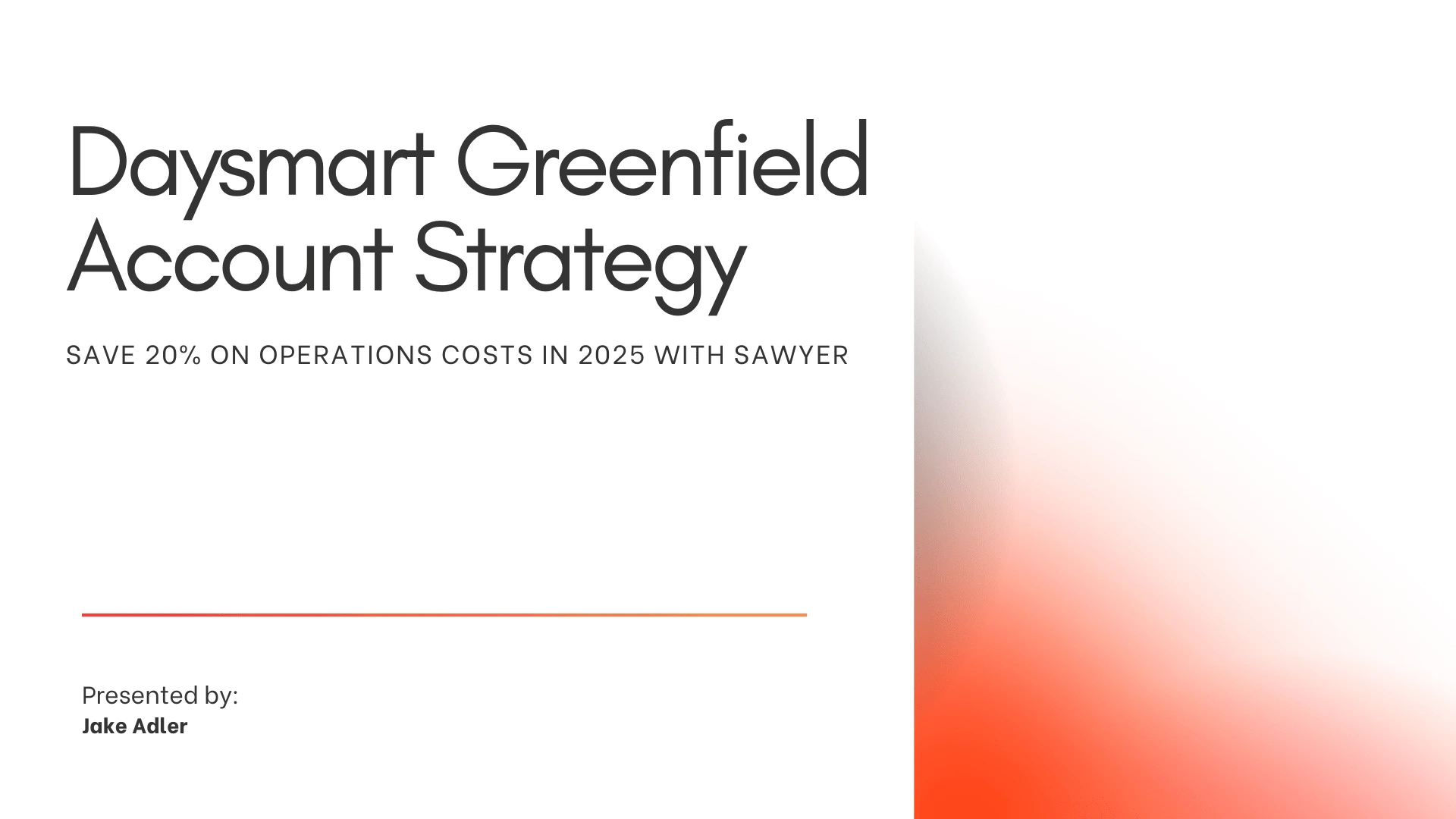
Slide 1
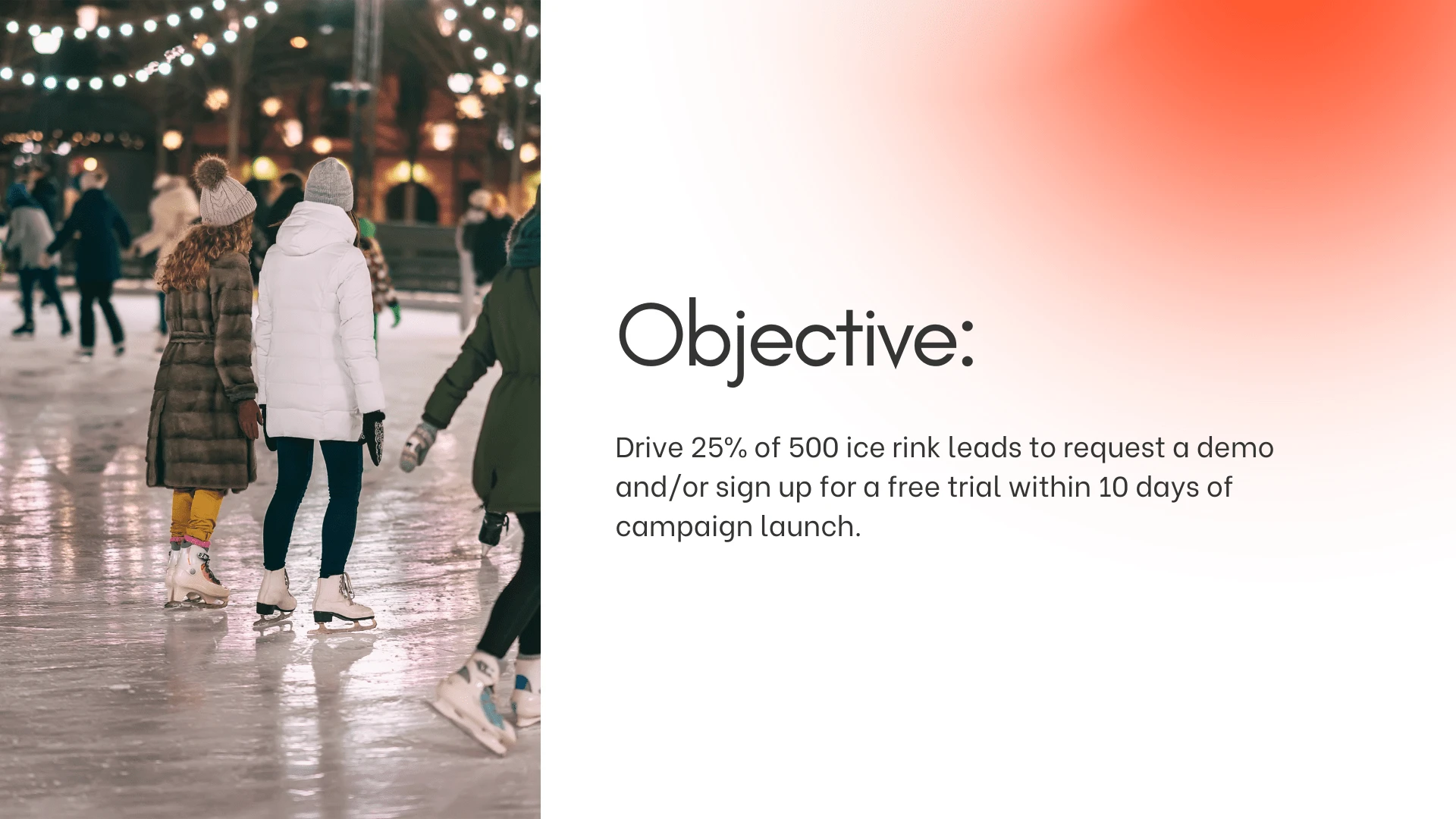
Slide 2
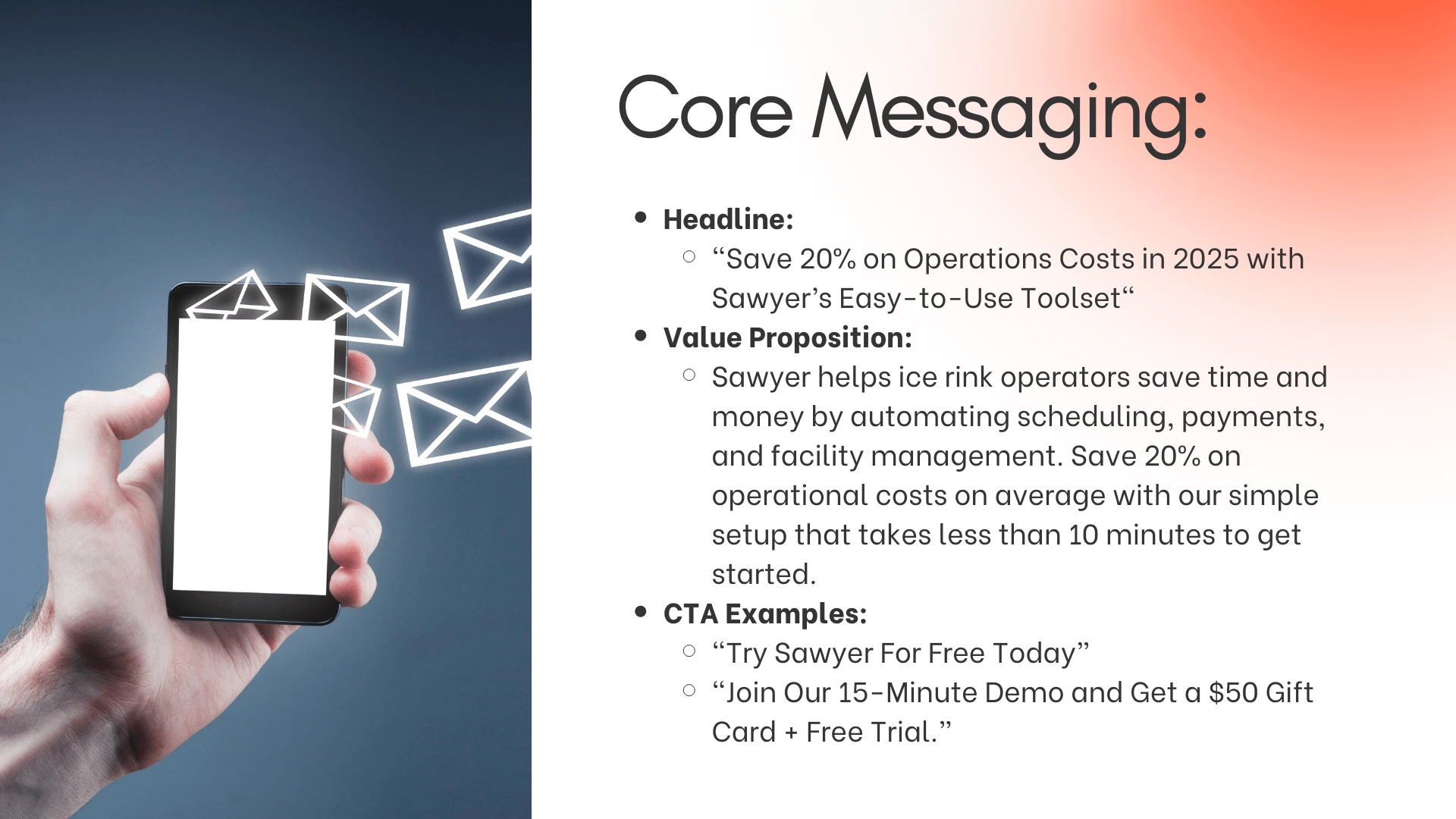
Slide 3
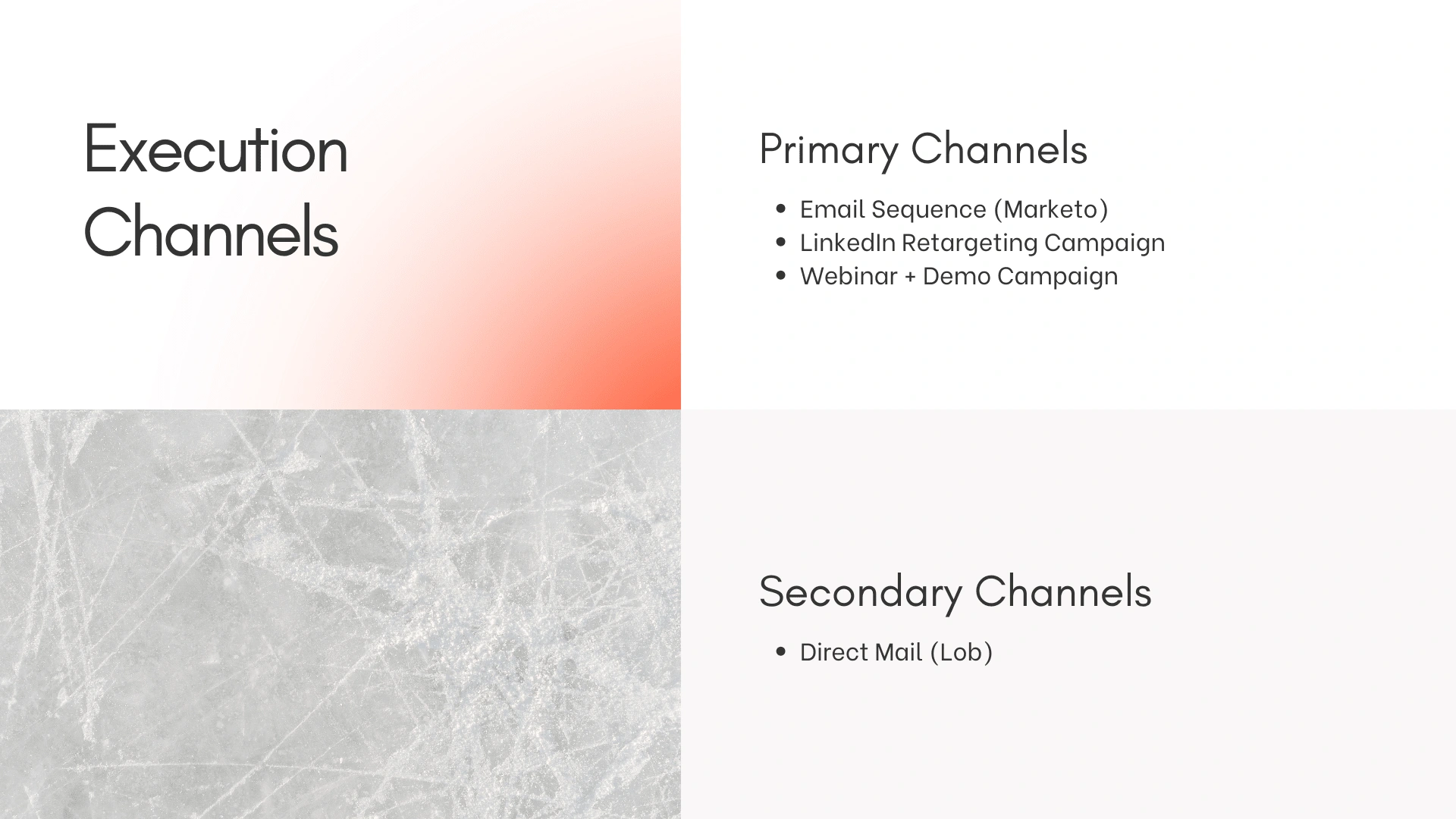
Slide 4

Slide 5
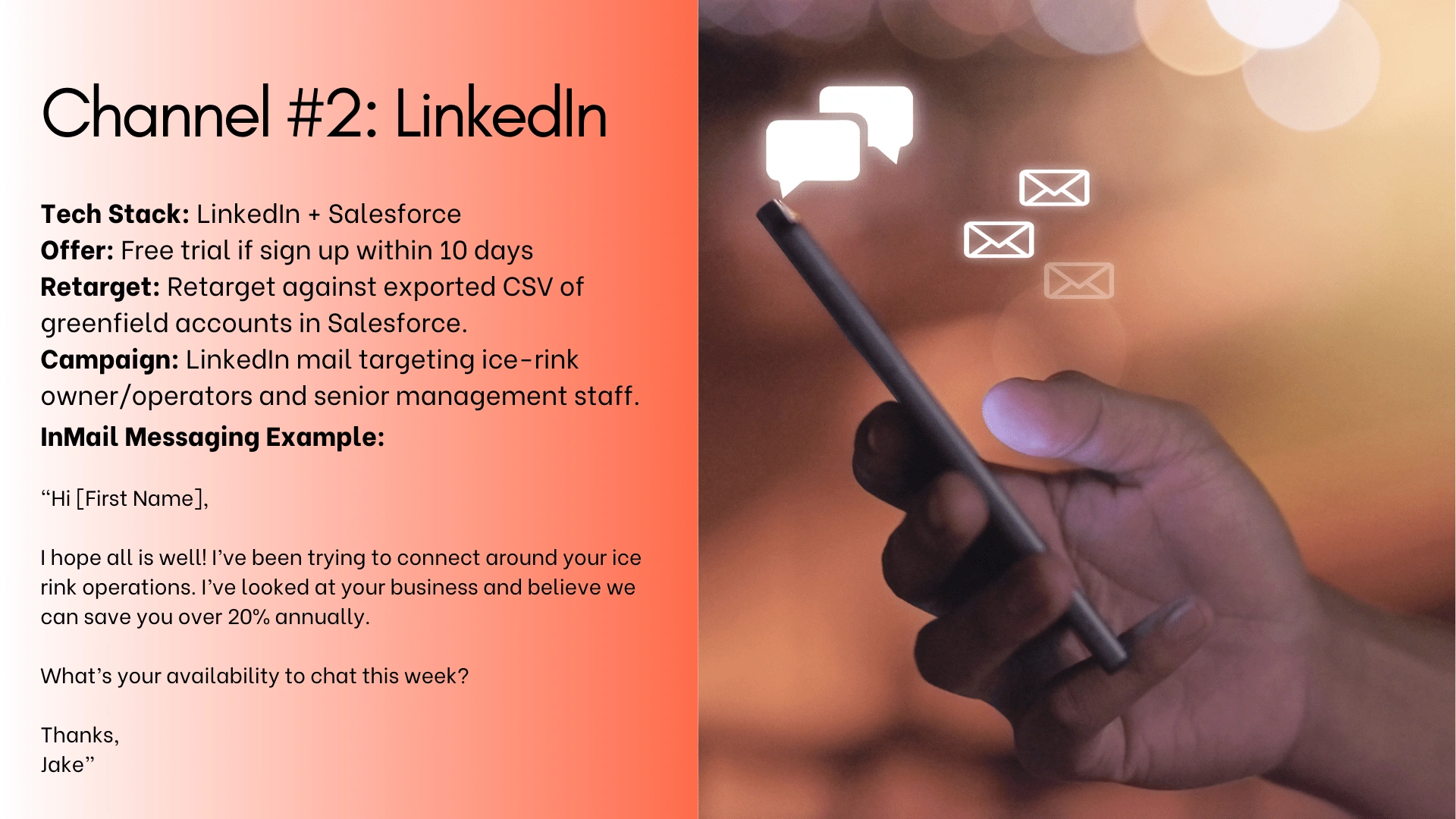
Slide 6
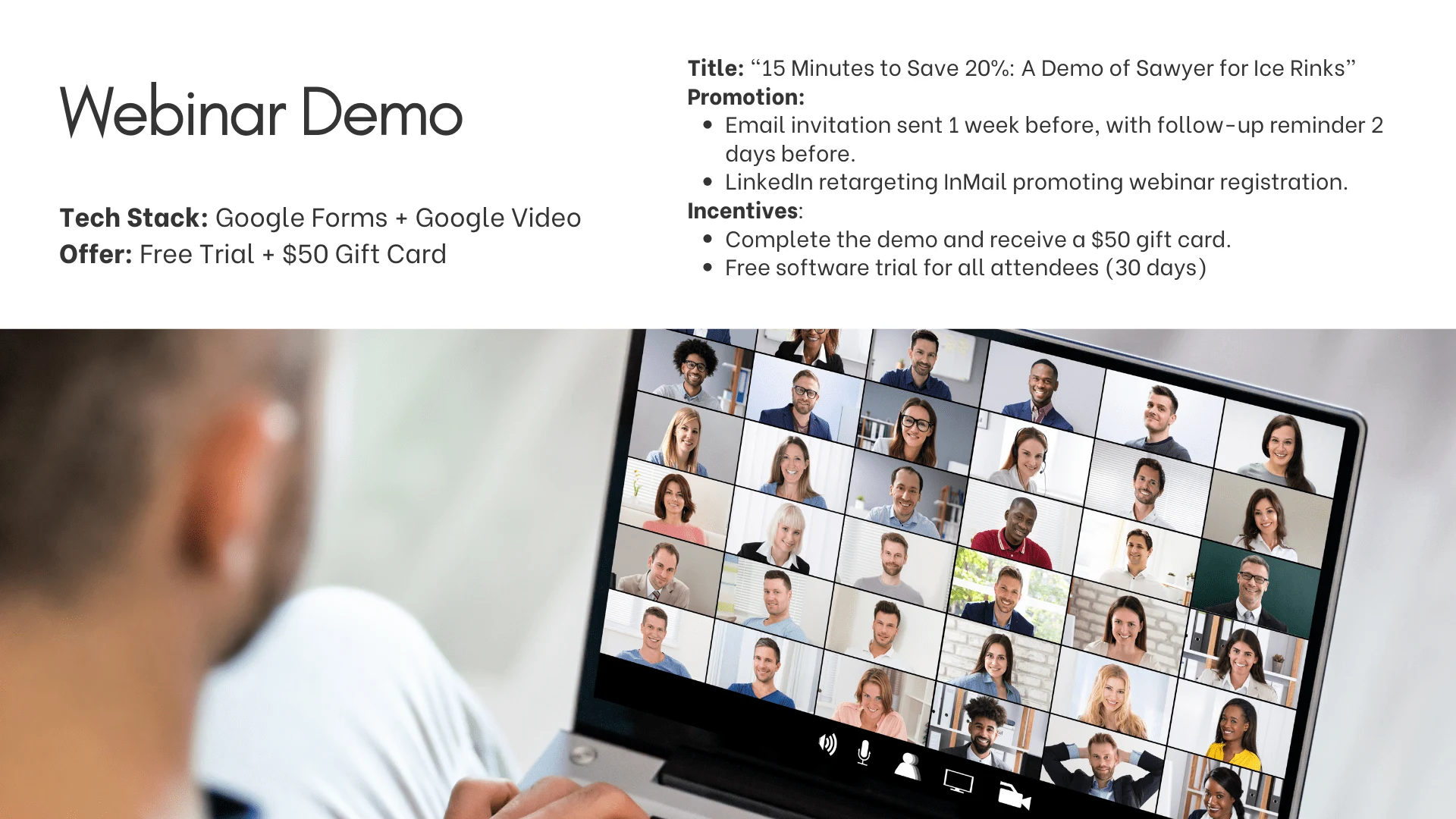
Slide 7
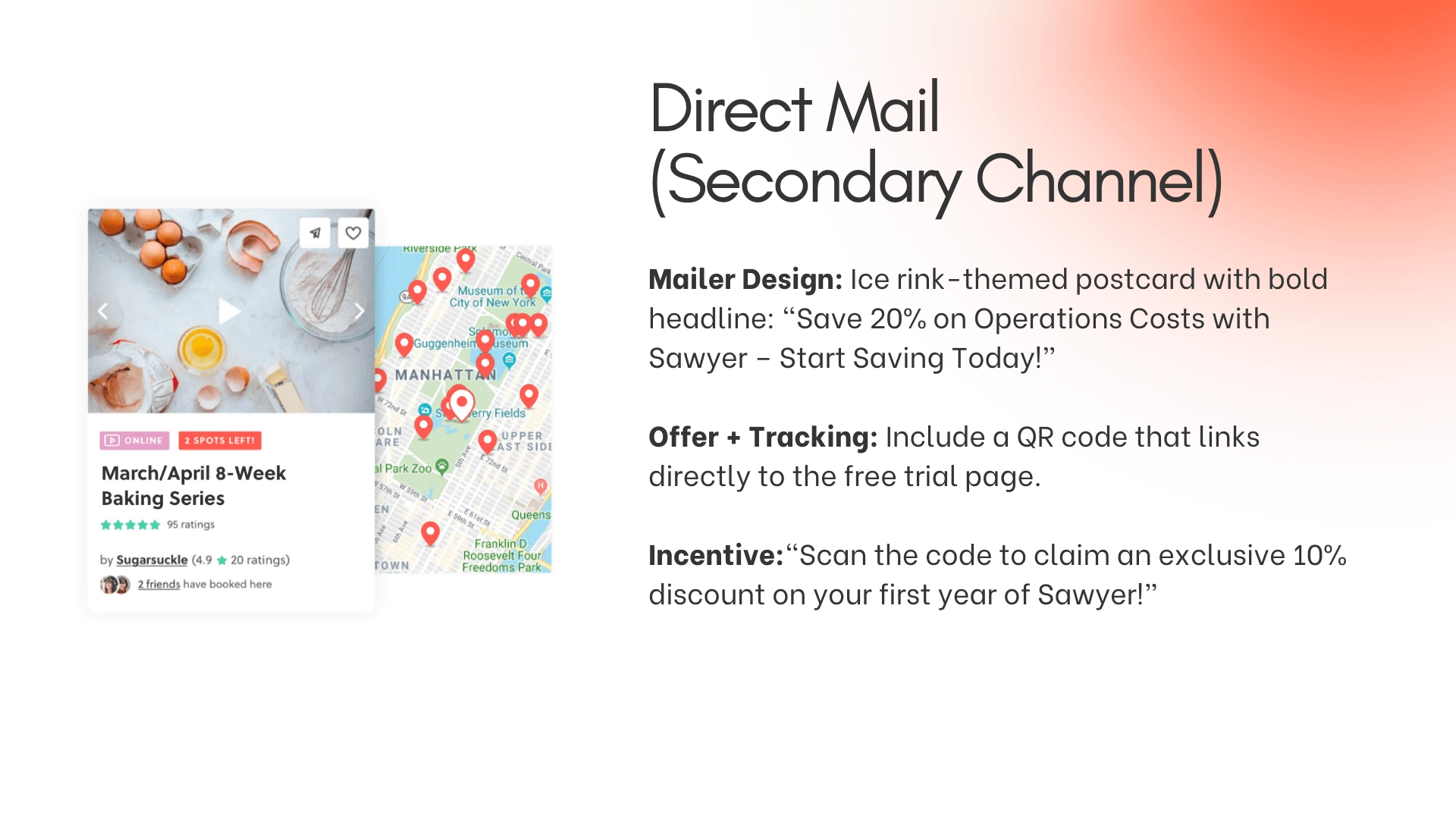
Slide 8
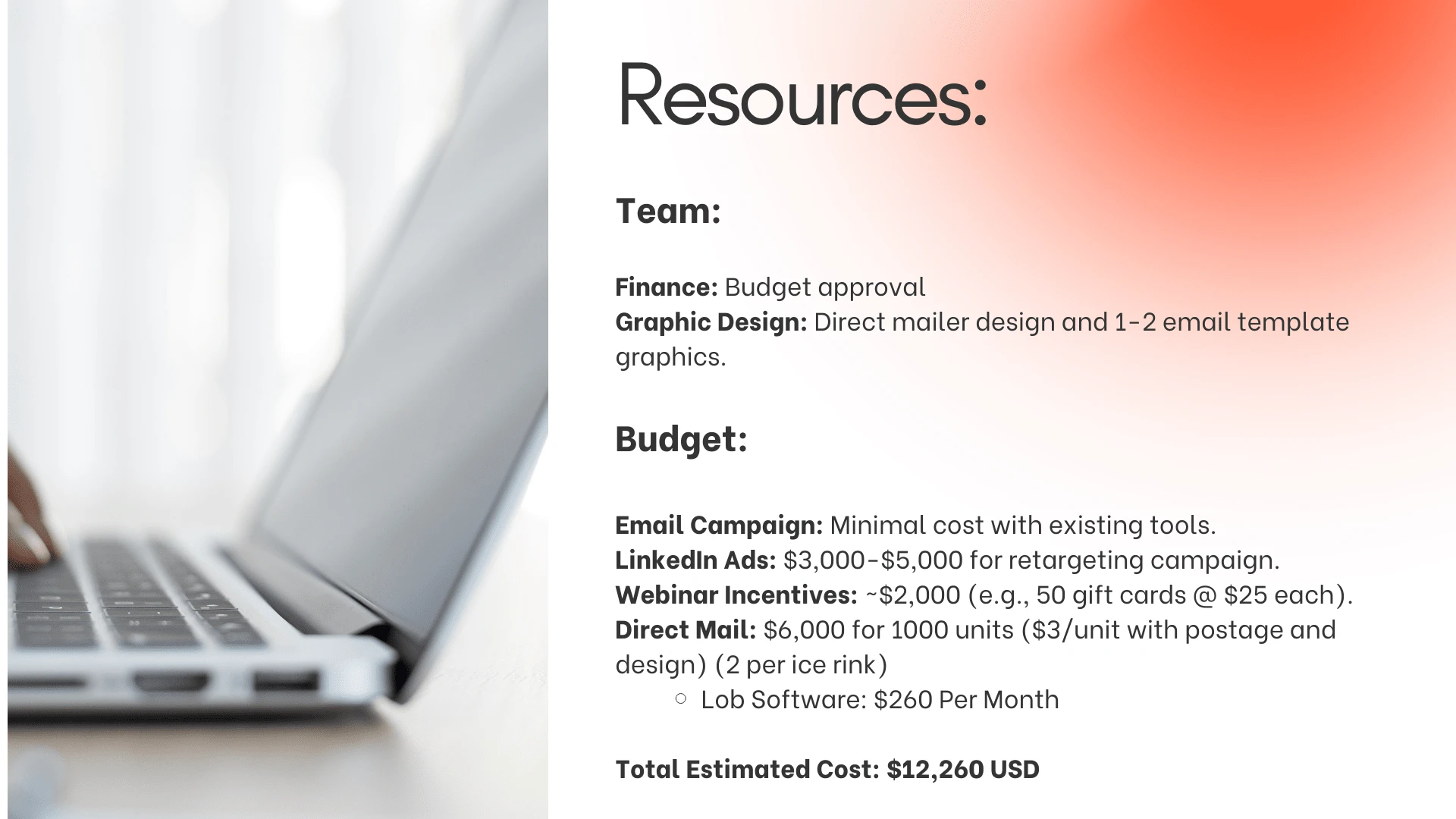
Slide 9
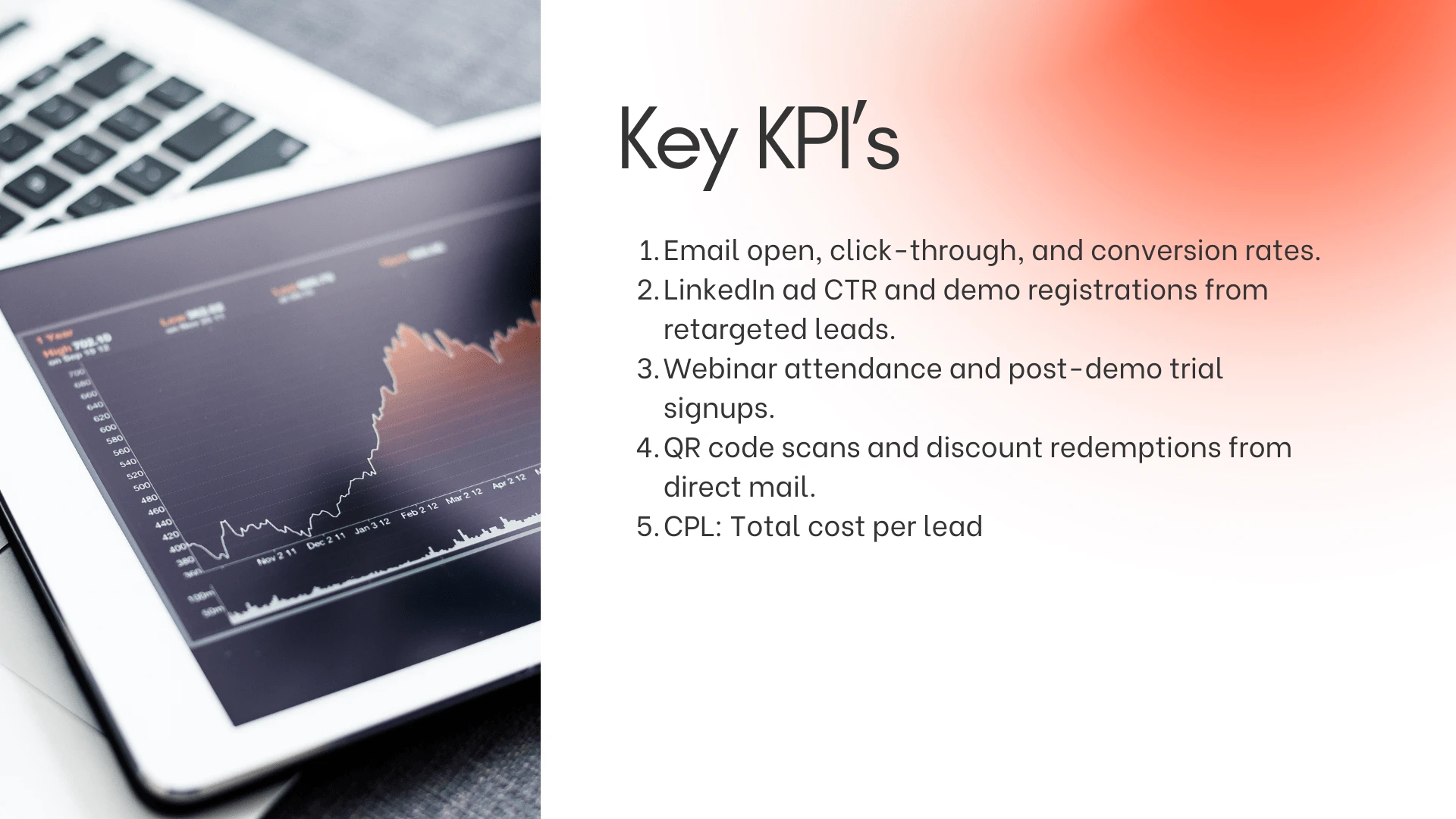
Slide 10
For any questions or inquiries, please reach out at jake@jakeadlerprojects.com.
Like this project
Posted Mar 11, 2025
Here are various case studies I've partaken in over the last 12 months focused on SaaS and technology companies in the US.

